DATE : 14TH SEPTEMBER , 2020.
Hello students, is nice reaching out to you once again.How are you all doing? I hope you are all safe as I pray that God should continue to protect us in this trying moment.
Today’s lesson is going to be as interesting as the previous one. So today , we shall be looking at -Husbandry of Pepper.
LESSON : 16
By the end of today’s lesson, you should be able to :
1.State the ecological conditions required by pepper;
2.State the cultural or agronomic practices needed in pepper cultivation ; and
3. State the harvesting ,processing and storage of pepper.
TOPIC: HUSBANDRY OF PEPPER.
INTRODUCTION
Pepper(Capsicum spp ) is a spice crop which belongs to the plant family called solanaceae . It is rich in vitamins and minerals. It adds flavor to our stew and soup as it can be used when green or red. Generally , ripe pepper fruits are red and contain a high concentration of capsicine which gives them their hot taste. Important species grown in Nigeria include the Nigerian bird’s eye ( Capsicum annuum ) and the long , narrow and very pungent specie. ( Capsicum frutescens ).
VARIETIES:
- Long pepper;
- Cherry pepper;
- Black pepper;
- Chilli pepper;
- Sweet pepper;
- Large chilli.

CHILLI PEPPER PODS
LAND PREPARATION:
Land is cleared using cutlass and hoe manually or mechanically done using Plough , harrow and ridger .
CLIMATIC REQUIREMENT:
- Temperature between 250C -300C is required.
- Rainfall between 65cm -130cm per annum is required.
SOIL REQUIREMENT:
Pepper requires a rich well-drained loamy soil.
METHOD OF PROPAGATION:
It is propagated by seeds.
PLANTING DATE:
Planting date for nursery is between February – March while on the field is between April – May.
SPACING:
Nursery spacing is between 5cm by 5cm and on field is between 60cm by 60cm.
NURSERY PRACTICES:
- Seeds are drilled in seed boxes or trays containing top soil with shade provided.
- Watering is done every morning and evening.
- Weeding is also done regularly.
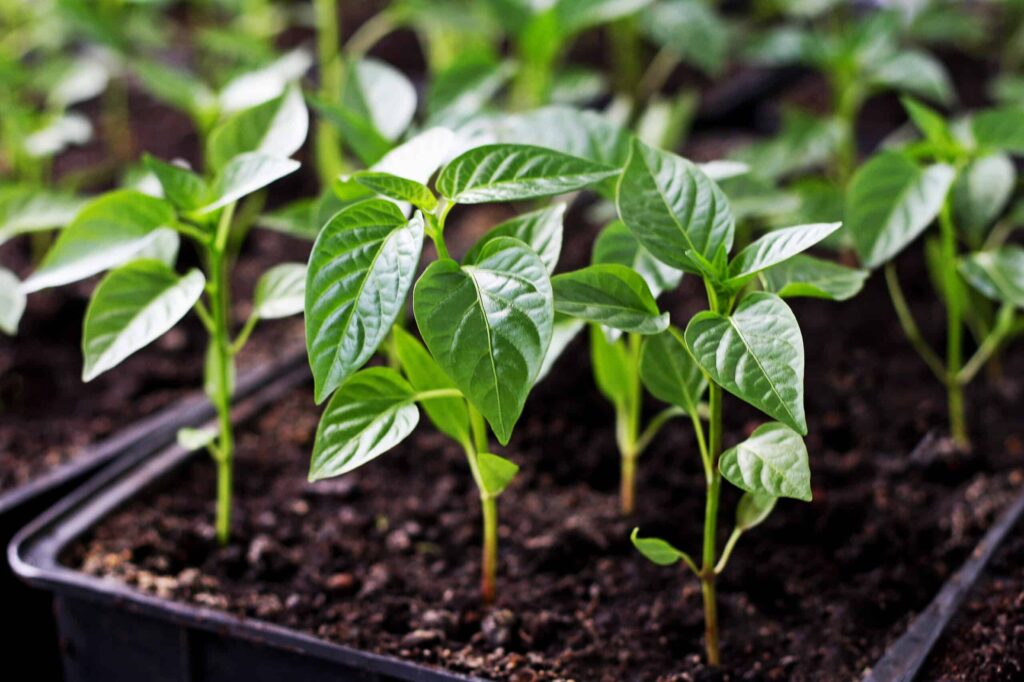
PEPPER SEEDLINGS READY FOR TRANSPLANTING.
FIELD PLANTING:
The growing seedlings, with a height of about 10cm – 15cm are transplanted to the main field with a ball- of –earth on the roots around April and May .
OTHER CULTURAL PRACTICES :
- Weeding;
- Mulching;
- Fertilizer application of ammonium sulphate at 100kg/ha by ring method.
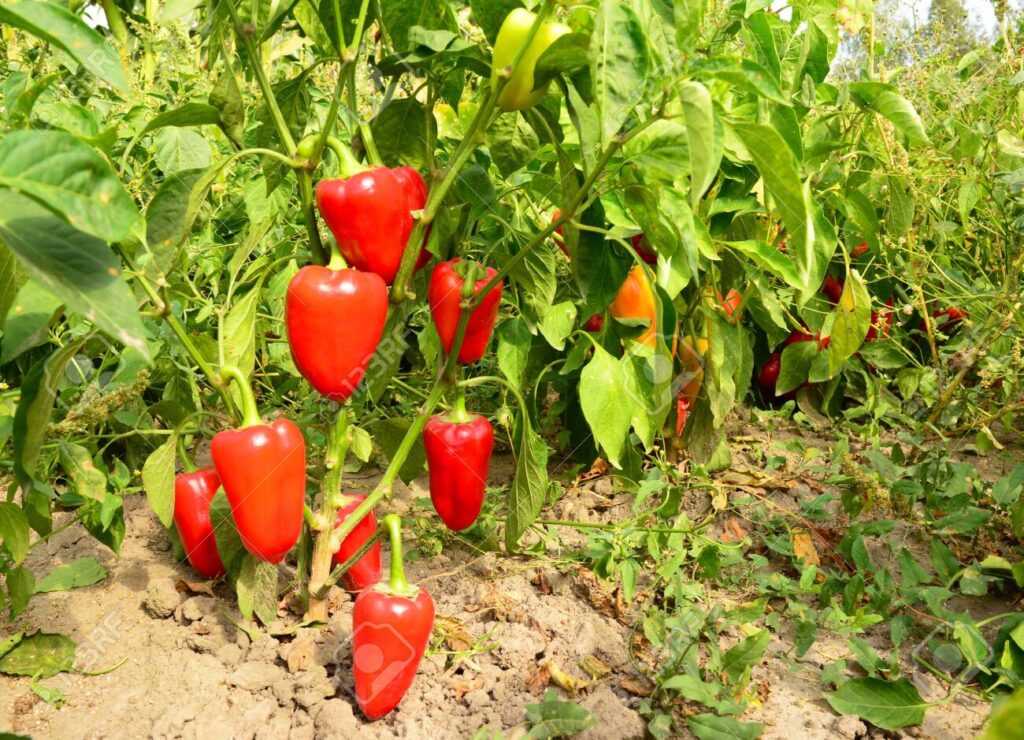
RIPE BELL PEPPER FRUITS ON THE FIELD.
MATURITY PERIOD :
Pepper matures between 2 -3 months after transplanting depending on the varieties .
HARVESTING:
Ripe or unripe pepper fruits can be harvested with hand or with harvested knife.
PROCESSING :
Ripe fruits can be dried or cured day and night for 6 – 14 days depending on the weather condition.
STORAGE :
Dried pepper are stored in sacks and kept in worm places in both the dry and powdered form.
PESTS OF PEPPER :
- Grasshopper;
- Cricket;
DISEASES OF PEPPER :
- Damping off;
- Leaf curl
- Leaf spot.
I hope you have learned a few things from today’s lesson. Answer the assignment questions below and submit your answers using the form below it after supplying your name , class and E-mail address. Thank you and stay safe.
ASSIGNMENT:
Mention three (3) pests that can affect pepper during storage ?
CORRECTION OF LESSON 15 ASSIGNMENT
- Soft oil ,i.e , palm oil with low free fatty acid (f f a );
- Hard oil ,i.e , palm oil with high free fatty acid (f f a );
- Special oil ,i.e , palm oil with very low free fatty acid (f f a ).
DATE : 7TH SEPTEMBER , 2020.
Hello students, is nice reaching out to you once again.How are you all doing? I hope you are all safe as I pray that God should continue to protect us in this trying moment.
Today’s lesson is going to be as interesting as the previous one. So today , we shall be looking at -Husbandry of Oil palm.
LESSON : 15
By the end of today’s lesson, you should be able to :
1.State the ecological conditions required by oil palm;
2.State the cultural or agronomic practices needed in oil palm cultivation ; and
3. State the harvesting ,processing and storage of oil palm.
TOPIC: HUSBANDRY OF OIL PALM .
INTRODUCTION
Oil palm(Elaeis guineensis ) is an oil crop which belongs to the plant family called Palmea . It originated in the tropical West Africa. The fruit is called a drupe which has a fairly thin exocarp surrounding the mesocarp , the fibrous oily layer where palm oil is extracted from. The endocarp , or shell ,surrounds the seed or kernel.
VARIETIES:
- Dura;
- Pisifera;
- Tenera ( A cross between dura and pisifera ).
LAND PREPARATION:
Land is cleared using cutlass and hoe manually or mechanically done using tractor , Plough and harrow .
CLIMATIC REQUIREMENT:
- Temperature between 180C -270C is required.
- Rainfall between 150cm -200cm per annum is required.
SOIL REQUIREMENT:
Oil palm requires rich well-drained slightly acidic soils of PH of 4.0 -5.6.
METHOD OF PROPAGATION:
It is propagated by seed . Germination can be done under natural conditions which is slow and few seeds germinate or many artificial methods. For successful germination, the dry heat method is the best where 80 -90 percent germination can be achieved. Here, the seeds are soaked in water for 7 days, the water being changed every day.The seeds are then dried in the shade for 24 hours .Next they are packed into polythene bags and are kept in a germinator for 80 days at 300C. After this , the seeds are again soaked in water for 7 days , the water being changed daily. The seeds are dried for 2 days and they become black in appearance. The seeds are again returned to polythene bags, kept in a cool place and watered lightly. Rapid germination occurs after another 3 weeks.
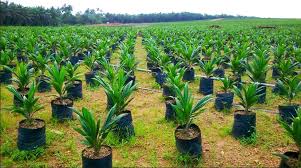
RAISED OIL PALM SEEDLINGS IN POLYTHENE BAGS.
PLANTING DATE:
During pre-nursery , it is between August – October .Nursery is nine months after pre-nursery and transplanted a year after on the field.
SPACING:
- Pre –nursery : Between 7cm by 7cm.
- Nursery : Between 60cm by 60cm.
- Field :Between 9m by 9m.
PRE – NURSERY PRACTICES:
- Plant the seeds in seed boxes or trays containing top soil which is rich in humus.
- The seeds are sown at a spacing 7cm by 7cm.
- Watering is done twice daily ,i.e , morning and evening.
- Mulching is carried out and sheds provided.
- Pre-nursery last for about 4 – 5 months before the seedlings are transferred to the nursery.
NURSERY PRACTICES:
- A well drained loamy soil is needed.
- The seedlings are spaced at a distance of 60cm by 60cm in polythene bags.
- Planting is done in early April during which the seedlings are removed with a ball- of -earth.
- Watering , mulching and weeding are carried out regularly.
FIELD PLANTING:
The growing seedlings are transplanted to the main field with a ball- of –earth on the roots after a year at a planting depth of about 45cm and at a spacing of 9m by 9m in a triangular form between April and May.
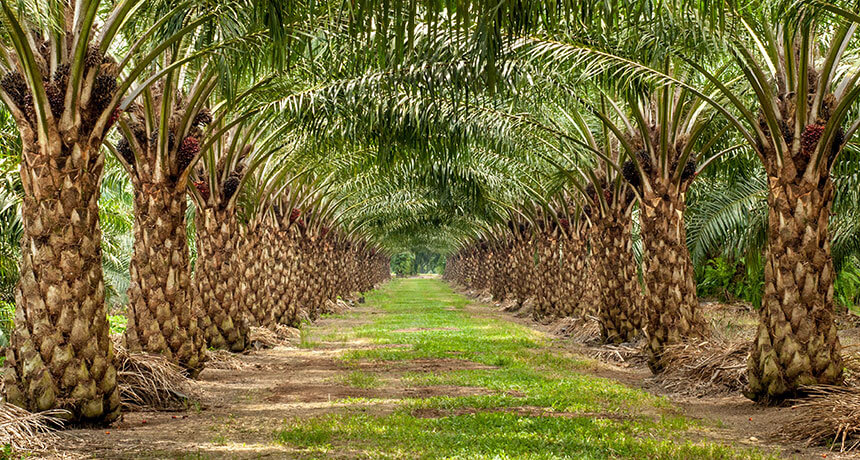
AN OIL PALM PLANTATION
OTHER CULTURAL PRACTICES :
- Regular weeding.
- Fertilizer application using N P K 15:15:15 .
- Planting of cover crops.
- Pruning..
MATURITY PERIOD :
Oil palm matures between 3 -7 years after planting depending on the varieties .
HARVESTING:
Ripe fruit bunches are harvested with a cutlass or harvested knife when the fruits are red or dark-red in colour with a few loose fruits dropping from the mature bunches.

RIPE OIL PALM FRUITS
PROCESSING :
There are two (2) methods of processing oil palm fruits.These are :
- Traditional method : The fruits are boiled after which they are pounded in a mortar. The fibres and nuts are removed and the oil is separated from the residue by floatation after mixing with water. The crude liquid is reboiled and the oil is carefully separated. The oil is later re-heated to eliminate any trace of water.
- Modern method : This involves the extraction of oil with machines. The boiled fruits are macerated to separate the oil from the fibre and the kernel. Hand-screw press or the hand-hydraulic press is used to press the mixture. The oil is cleansed by allowing the mixture to settle and then boiled after the sludge and water have been removed. The oil is then re-heated to remove any traces of water storage.
STORAGE :
Palm oil is stored in aluminium or plastic containers , drum , tins , or bottles while the kernels are cracked , dried and stored in kenaf or jute bags .
PESTS OF OIL PALM :
- Rhinoceros beetle;
- Locust;
- Rodents.
DISEASES OF OIL PALM :
- Anthracnose;
- Blast;
- Freckle;
- Galadima disease
I hope you have learned a few things from today’s lesson. Answer the assignment questions below and submit your answers using the form below it after supplying your name , class and E-mail address. Thank you and stay safe.
ASSIGNMENT:
Mention the three (3) grades of oil palm based on the quantity of free fatty acid (f f a) present in the oil?
CORRECTION OF LESSON 14 ASSIGNMENT
- It is used in the manufacture of tyres and rainboats.
- It is used in the production of covers of electric cables.
DATE : 31ST AUGUST , 2020.
Hello students, is nice reaching out to you once again.How are you all doing? I hope you are all safe as I pray that God should continue to protect us in this trying moment.
Today’s lesson is going to be as interesting as the previous one. So today , we shall be looking at -Husbandry of Rubber.
LESSON : 14
By the end of today’s lesson, you should be able to :
1.State the ecological conditions required by rubber;
2.State the cultural or agronomic practices needed in rubber cultivation ; and
3. State the harvesting ,processing and storage of rubber.
TOPIC: HUSBANDRY OF RUBBER .
INTRODUCTION
Rubber(Hevea brasiliensis ) is a latex crop which belongs to the plant family called Euphorbiaceae . It originated in the Amazon rain forest region around Para in Brazil. It is the only popular latex crop which produces white sticky liquid used in plastic industries.
VARIETIES:
- PB 86;
- PB5/51;
- BD5;
- Harbel 1;
- Dough garden;
- RR1600;
- GTI;
- RR1513.
LAND PREPARATION:
Land is cleared using cutlass and hoe manually or mechanically done using tractor , Plough and harrow .
CLIMATIC REQUIREMENT:
- Temperature between 240C -290C is required.
- Rainfall between 180cm -300cm per annum is required.
SOIL REQUIREMENT:
Rubber requires a deep , fertile slightly acidic and permeable loamy soil rich in humus.
METHOD OF PROPAGATION:
It can be propagated by seed , grafted or budded seedling.
PLANTING DATE:
During pre-nursery , it is between August – October. The young seedlings are budded after one year of sowning or planting and transplanted 10 – 11 months after budding on the field.
SPACING:
- Pre –nusery between 3cm by 3cm.
- Nursery between 60cm by 60cm.
- On field between 4m by 6m.
PLANTING :
4 – 5 seeds are sown per stand.
PRE – NURSERY PRACTICES:
The seeds are planted in fertile top soil near a river.They are also heavily watered and covered with dry grasses which serve as mulch. Germination occurs 7 – 10 days after planting.
NURSERY PRACTICES:
The seeds are planted on a rich fertile soil at a spacing of 60cm by 60cm.Watering is done twice a day ( morning and evening) and mulching is also carried out.

RUBBER SEEDLINGS IN THE NURSERY.
TRANSPLANTING:
The seedlings are transplated on the main field around March – June during the raining season. The seedling is transplanted with a ball of earth at a depth of between 15cm – 30 cm.
OTHER CULTURAL PRACTICES :
- Regular weeding.
- Fertilizer application using compound fertilizers of potash , phosphorus and magnesium at the early stage of development as well as N P K 15:15:15 when fully established.
- Planting of cover crops at the early stage of seedlings’ development to prevent evaporation and erosion.
- Mulching.
- Pruning of side shoots at early stage to produce smooth and straight trunk.
MATURITY PERIOD :
Rubber matures between 5 -7 years after planting depending on the varieties .
PESTS OF RUBBER :
- Mealy bugs;
- Bat.
DISEASES OF RUBBER :
- Tapping panel disease.
- White and red rot disease.
HARVESTING:
Harvesting of latex is done between the hours of 7- 10 in the morning every 2 – 5 days to tap latex. A diagonal cut is made 60cm -100cm above the ground on the bark of the tree with a tapping knife. A collecting cup is attached to the end of the cut and an aluminium slip helps to guide the latex into the cup. Tapping is the process of harvesting or collecting latex in the cup.
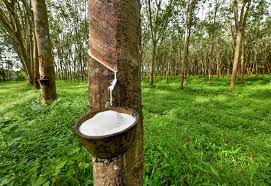
HARVESTING OF RUBBER LATEX.
PROCESSING :
- Latex is collected in a processing unit and a little water added to it.
- Formic or acetic acid is added for coagulation of the latex.
- The coagulated rubber is cut into pieces , washed and then cut into rubber sheets through a rolling machine.
- The rubber sheets are washed and coated with paranitro-phenol solution to prevent the growth of mould.
- The rubber sheets are dried and put into a smoke house for further drying.
- Talcum powder is applied to prevent the rubber sheets from sticking together and also for proper storage.
- Rubber is further processed into spoons , carpet , shoes , bags , cups , raincoats , tyres , covers of electric cables , etc.
STORAGE :
Rubber is stored in sacks or jute bags in dry places.
I hope you have learned a few things from today’s lesson. Answer the assignment questions below and submit your answers using the form below it after supplying your name , class and E-mail address. Thank you and stay safe.
ASSIGNMENT:
State two (2) uses of rubber to man?
CORRECTION OF LESSON 13 ASSIGNMENT
USES OF COTTON TO MAN
- Cotton is used for making cloth and threads.
- The seeds are used in preparing soup.
- The oil extracted is used for making vegetable oil and soap.
- It is used to manufacture bandages , cotton wool and other sanitary materials.
DATE : 24TH AUGUST , 2020.
Hello students, is nice reaching out to you once again.How are you all doing? I hope you are all safe as I pray that God should continue to protect us in this trying moment.
Today’s lesson is going to be as interesting as the previous one. So today , we shall be looking at -Husbandry of Cotton.
LESSON : 13
By the end of today’s lesson, you should be able to :
- State the ecological conditions required by cotton;
- State the cultural or agronomic practices needed in cotton cultivation ; and
- State the harvesting ,processing and storage of cotton.
TOPIC: HUSBANDRY OF COTTON .
INTRODUCTION
Cotton(Gossypium spp ) is a fibre crop which belongs to the plant family called malvaceae . The flowers give rise to bolls ,the fruits , where the white fibre known as lint used in textile industries is derived.
VARIETIES:
- Gossypium hirsutum;
- Gossypium barbadense;
- Gossypium vitifolium;
- Ishan type;
- Samaru 69;
- Gossypium penivianum.
LAND PREPARATION:
Land is cleared using cutlass and hoe manually or mechanically done using Plough , harrow and ridger.
CLIMATIC REQUIREMENT:
- Temperature between 250C -350C is required.
- Rainfall between 65cm -125cm per annum is required.
SOIL REQUIREMENT:
Cotton requires a deep rich loam or clay-loamy soil with a PH of 5.8 – 8.0.
METHOD OF PROPAGATION:
Cotton is propagated by seed .
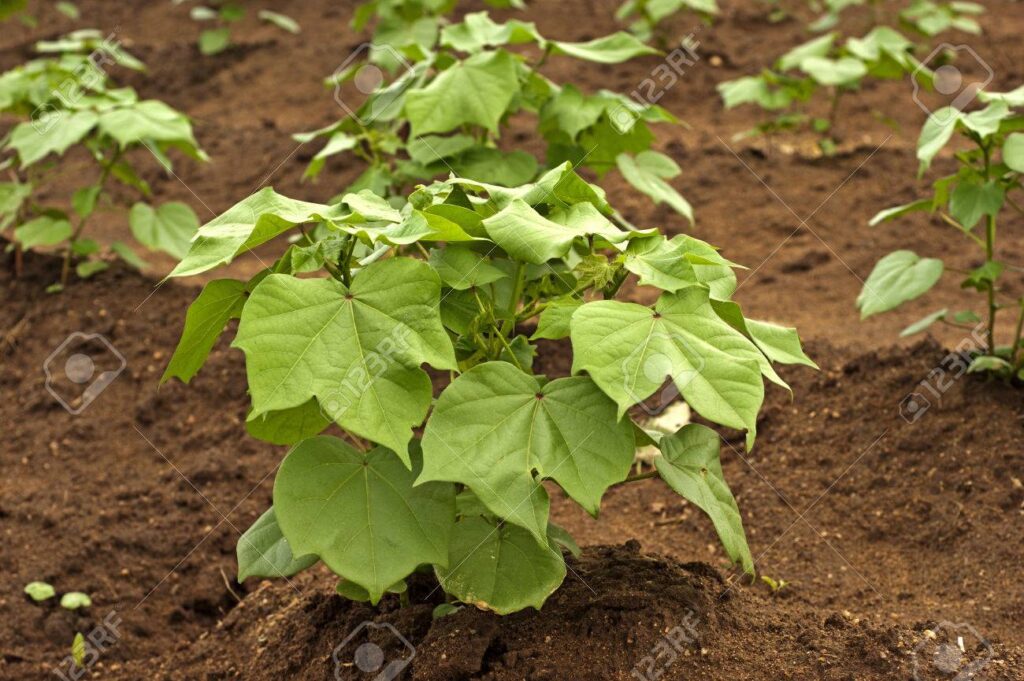
YOUNG COTTON PLANTS( SEEDLINGS ).
PLANTING DATE:
Cotton is planted mostly in the north between June –July and May to early July in the south.
SPACING:
It is 45cm by 60cm within the rows and 90cm by 100cm between the rows on flat land.
PLANTING :
4 – 5 seeds are sown per stand.
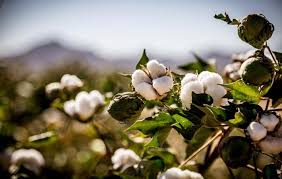
COTTON BOLLS WITH LINT.
CULTURAL PRACTICES :
- Thinning , i.e , to two seedlings per stand.
- Regular weeding.
- Fertilizer application using super phosphate during planting.
- Mulching to prevent evaporation and control erosion.
MATURITY PERIOD :
Cotton matures between 5 -8 months after planting depending on the varieties .
PESTS OF COTTON :
- Boll worm.
- Cotton stainer (Dysdercus spp ).
DISEASES OF COTTON :
- Damping off.
- Bacterial blight.
- Leaf curl.
HARVESTING:
Matured bolls are hand- picked and sun-dried when the lint is dry.
PROCESSING :
The lint is picked from the seeds by hand or by machine in a ginnery. This is made into bales by hand or baling machine. The process of separating the lint from the seeds is called GINNING..
STORAGE :
Cotton is stored in sacks or jute bags in dry places.
I hope you have learned a few things from today’s lesson. Answer the assignment questions below and submit your answers using the form below it after supplying your name , class and E-mail address. Thank you and stay safe.
ASSIGNMENT:
State four (4) uses of cotton to man?
CORRECTION OF LESSON 12 ASSIGNMENT
REASONS FOR FERMENTING COCOA BEANS.
- To get proper taste and colour of cocoa products.
- To improve the aroma and produce chocolate flavor.
- To kill the embryo and discourage germination.
- To render the cocoa beans brittle.
DATE : 17TH AUGUST , 2020.
Hello students, is nice reaching out to you once again.How are you all doing? I hope you are all safe as I pray that God should continue to protect us in this trying moment.
Today’s lesson is going to be as interesting as the previous one. So today , we shall be looking at -Husbandry of Cocoa.
LESSON : 12
By the end of today’s lesson, you should be able to :
- State the ecological conditions required by cocoa;
- State the cultural or agronomic practices needed in cocoa cultivation ; and
- State the harvesting ,processing and storage of cocoa.
TOPIC: HUSBANDRY OF COCOA .
INTRODUCTION
Cocoa(Theobroma cacao) is a beverage crop belonging to family sterculaceae . It is grown in Ghana , Cote D ‘ voire , Brasil , Nigeria and Cameroon. Cocoa production is concentrated in Oyo , Ondo and Ogun States of Nigeria. The fruit of cocoa is called pod.
VARIETIES:
- Upper Amazon (Amazon );
- Criollo;
- Amelonado (Forastero);
- West African Cocoa Hybrid (Hybrid);
- Trinitario.
LAND PREPARATION:
Land is cleared using cutlass or tractor and after this , stumping is done. Ploughing and harrowing will then proceed.
CLIMATIC REQUIREMENT:
- Temperature between 170C -210C is required.
- Rainfall between 114cm -200cm per annum is required.
SOIL REQUIREMENT:
Cocoa requires a well drained deep loamy-clayed soil which is slightly acidic.
METHOD OF PROPAGATION:
Cocoa is propagated by :
- Seeds;
- Budded seedlings;
- Grafted seedlings.
PLANTING DATE:
In the nursery , planting date is between October –January while the field planting is between April and June .
SPACING:
In the nursery, it is 20cm by 20cm while field spacing is 3m by 3m during transplanting.
NURSERY PRACTICES :
These include :
- Filling of loamy soil in polythene bags.
- Sowing of one seed in each polythene bag.
- Watering of seeds in the morning and evening.

COCOA SEEDLINGS IN A NURSERY.
TRANSPLANTING :
Cocoa seedlings are transplanted to the main field at a spacing of 3m by 3m and a depth of 45cm . Nurse plant such as cassava ,cocoyam , plantain or banana is allowed to grow along with cocoa seedlings to produce or provide temporary shading.
CULTURAL PRACTICES :
- Weeding .
- Shading.
- Fertilizer application using ammonium sulphate .
- Mulching.
- Irrigation.
- Supplying.
- Regeneration.
- Pruning to remove lower branches in order to encourage young shoots to grow and prevent disease spread.
MATURITY PERIOD :
Cocoa matures 3 -5 years depending on the varieties .
PESTS OF COCOA :
- Cocoa capsid.
- Mealy bug.
DISEASES OF COCOA :
- Swollen shoot disease.
- Black pod disease.
HARVESTING:
Ripe and matured cocoa pods are harvested by using harvesting knife, sharp cutlass or sickle.
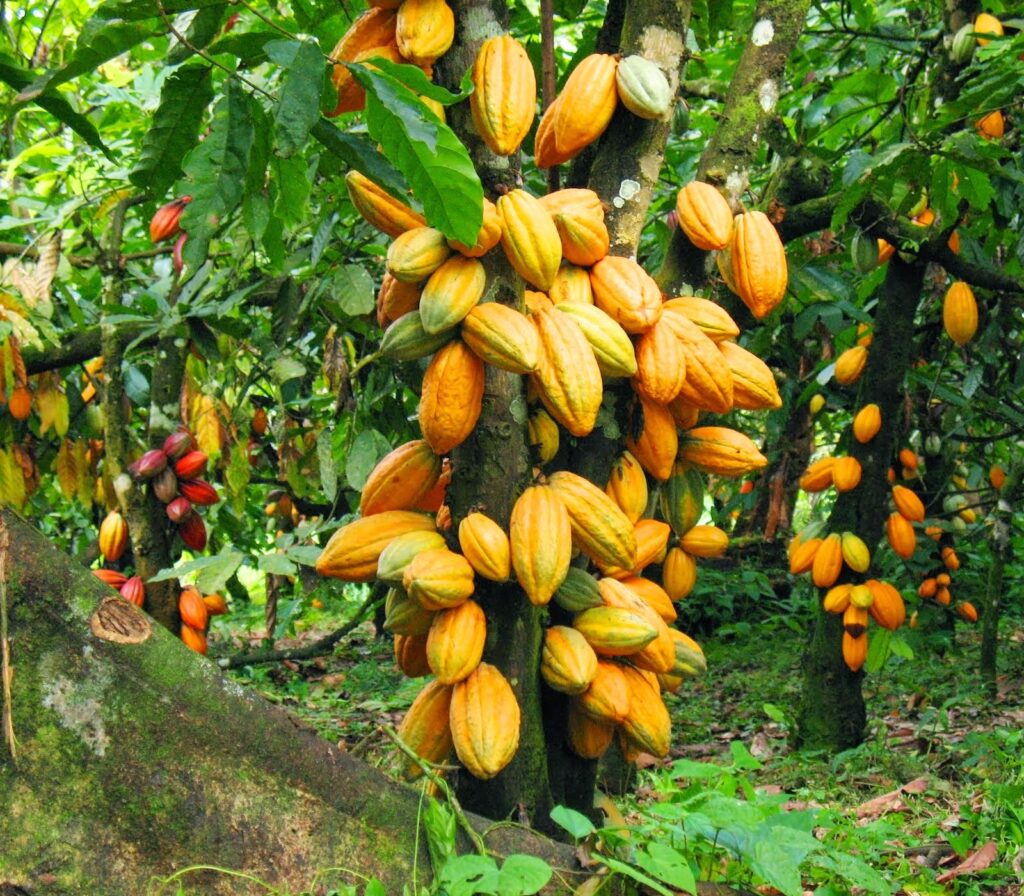
A COCOA PLANTATION.
PROCESSING :
These include
- Breaking of pods.
- Fermentation.
- Drying.
BREAKING OF PODS: Cocoa pods are opened by hitting them with heavy metal or rod or by using a blunt knife to remove the cocoa beans.
FERMENTATION : Cocoa beans are fermented in trays , baskets or perforated boxes lined with plantain or banana leaves for five days. It may also be fermented in heaps heavily covered with leaves. During fermentation process , cocoa beans undergo chemical changes brought about by the action of heat generated by the beans which kills the embryo and cures the beans. The fermented cocoa beans contain THEOBROMINE which acts as a stimulant in cocoa drinks.
DRYING : After fermentation , the beans are sun-dried for 6 – 10 days to a low moisture content of about 6 – 8 %.
Cocoa can be processed into cocoa butter , cocoa powder , cocoa liquor etc. Cocoa pods or husks can also be used in feeding livestock , source of fuel and the production of local soap.
STORAGE :
Properly dried cocoa beans are stored in sacks or jute bags.
I hope you have learned a few things from today’s lesson. Answer the assignment questions below and submit your answers using the form below it after supplying your name , class and E-mail address. Thank you and stay safe.
ASSIGNMENT:
State four (4) reasons for fermenting cocoa beans?
CORRECTION OF LESSON 11 ASSIGNMENT.
USES OF Citrus sinensis .
- It is a good source of vitamin C in human diet.
- The pulp can be used in feeding livestock.
- The juice is used in the production of fruit drinks.
- Strongly scented volatile oils produced from the peels can serve as insect repellant for stored grains.
DATE : 10TH AUGUST , 2020.
Hello students and how are you all doing? I hope you are all safe as I pray that God should continue to protect us in this trying moment.
So today , we shall be looking at -Husbandry of Citrus.
LESSON : 11
By the end of today’s lesson, you should be able to :
- State the ecological conditions required by citrus;
- State the cultural or agronomic practices needed in citrus cultivation ; and
- State the harvesting ,processing and storage of citrus fruits.
TOPIC: HUSBANDRY OF CITRUS .
INTRODUCTION
Citrus (Citrus spp) are small evergreen trees with spines on their stems producing succulent, fleshy and juicy fruits. They belonging to family called Rutaceae .Sweat orange (Citrus sinensis ) and grapefruit (Citrus paradise ) are the most important commercial varieties grown in Nigeria. Citrus fruit is a type of berry called hesperidium.
VARIETIES:
There are different varieties of citrus fruits . These include :
- Sweat orange;
- Bitter orange;
- King orange;
- Grape ;
- Lemon ;
- Lime ;
- Tangerine ;
- Shaddock ;

CITRUS FRUITS.
LAND PREPARATION:
Land is cleared using cutlass or tractor and after this , stumping is done. Ploughing and harrowing will then proceed.
CLIMATIC REQUIREMENT:
- Temperature between 250C -350C is required.
- Rainfall between 75cm -125cm per annum is required.
SOIL REQUIREMENT:
Land of higher elevation with a well drained fertile and deep soil is required.
METHOD OF PROPAGATION:
- Sexually by planting seeds.
- Asexually by budding (budded seedlings) and grafting (grafted seedlings).
PLANTING DATE:
Nursery is carried out between October and December and budding or grafting carried out a year later.
SPACING:
- Nursery spacing is 3cm by 3cm.
- Field spacing is 3m by 3m.
NURSERY PRACTICES :
- Seeds are raised in seed boxes or nursery beds on loamy soil rich in organic matter .
- Budding or grafting is done when the seedling’s thickness is about the size of a pencil.
- Budded or grafted seedlings are nursed for 18-24 months before they are ready for transplanting on the field.
CULTURAL PRACTICES :
- Weeding : Regular weeding until the seedlings are well established.
- Fertilizer application : Ammonium sulphate fertilizer is added at regular intervals.
- Mulching: This is carried out during dry season.
- Irrigation : This is carried out during dry season.
- Prunning : This is the cutting down of parts of a growing plant or tree to allow for penetration of light and circulation of air.
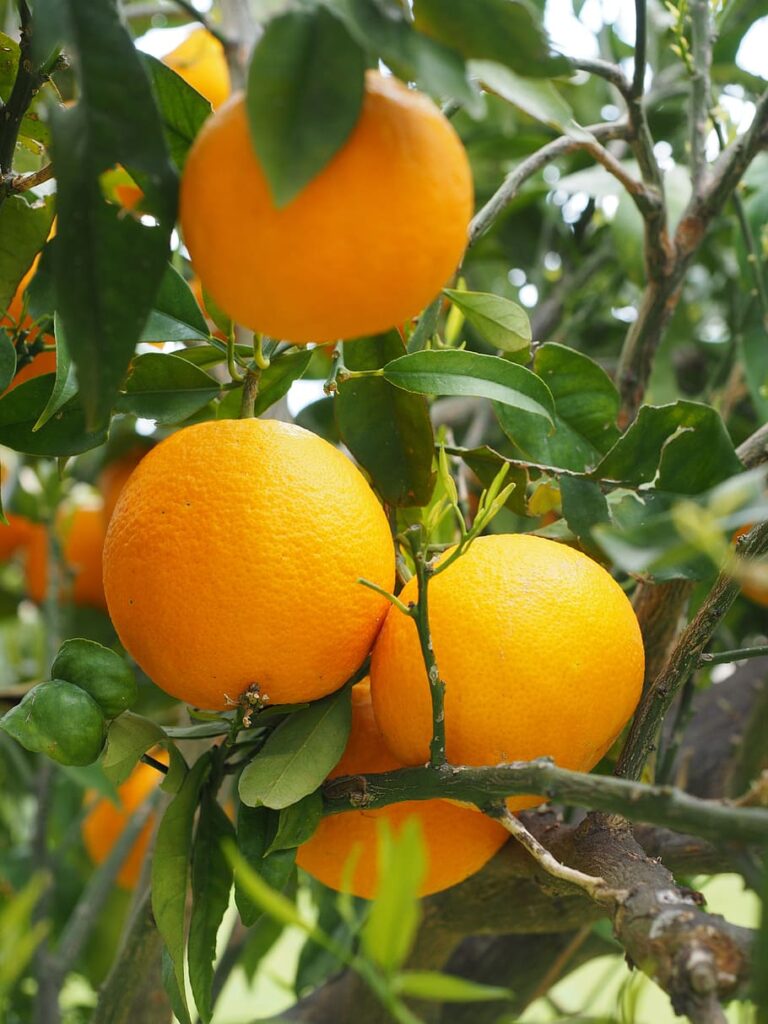
RIPE AND MATURED SWEAT ORANGE FRUITS ON CITRUS TREE.
MATURITY PERIOD :
Citrus matures 3 -7 years depending on the varieties .
PESTS OF CITRUS :
- Aphids;
- Caterpiller;
- Thrips;
- Scale insects;
- Red mites.
DISEASES OF CITRUS :
- Tristeza;
- Citrus scab;
- Gummosis.
HARVESTING:
Ripe and matured fruits are harvested with hand or harvesting knife.
PROCESSING AND STORAGE :
Citrus fruits can be processed into juice which can be stored in cans or bottles.
I hope you have learned a few things from today’s lesson. Answer the assignment questions below and submit your answers using the form below it after supplying your name , class and E-mail address. Thank you and stay safe.
ASSIGNMENT:
Mention four (4) uses of Citrus sinensis to man ?
CORRECTION OF LESSON 10 ASSIGNMENT.
WAYS OF PREVENTING DISEASES IN TOMATO
- Practice crop rotation.
- Plant disease resistant varieties.
- Treat soil with appropriate nematicides.
- Staking to prevent the fruits from coming in contact with soil borne diseases.
DATE : 3RD AUGUST , 2020.
Hello students and how are you all doing? I hope you are all safe as I pray that God should continue to protect us in this trying moment.
So today , we shall be looking at – Husbandry of tomato.
LESSON : 10
By the end of today’s lesson, you should be able to :
- State the ecological conditions required by tomato;
- State the cultural or agronomic practices needed in tomato cultivation ; and
- State the harvesting ,processing and storage of tomato.
TOPIC: HUSBANDRY OF TOMATO .
INTRODUCTION
Tomato ( Lycopersicum esculentum ) is a berry food that is classified as a vegetable crop..
VARIETIES:
There are different varieties of tomato . These include :
- Ibadan local;
- Roma;
- Purk;
- Bonny best;
- Harvester;
- Ife 1.
LAND PREPARATION:
Land can be cleared manually by using cutlass and ridges or heaps can be made using hoe. The land can also be prepared mechanically by using tractor ,plough and ridger to make ridges .
CLIMATIC REQUIREMENT:
- Temperature between 200C -250C is required.
- Rainfall between 50cm -125cm per annum is required.
SOIL REQUIREMENT:
A well drained loamy soil that is rich in organic matter.
METHOD OF PROPAGATION:
Tomato is propagated or planted by seeds using drilling method or broadcasting method.
PLANTING DATE:
Tomato is planted mostly in early September or October.
SPACING:
Spacing of tomato when staked is between 50cm by 80cm and without staking is between 60cm by 60cm.
NURSERY PRACTICES :
- Top soil rich in organic matter is put in seed boxes , trays , polythene bags or ground as nursery soil.
- Seeds are sown 5cm apart and 2.5cm deep using drilling method.
- Shading is provided to prevent direct effect of sunlight and rainfall.
- Mulching is carried out to conserve soil moisture.
- Watering is done regularly but not excessively.
- Transplanting is done three weeks after planting. This should be done in the morning or late in the evening and it is followed by watering.

TOMATO SEEDLINGS GROWING IN THE NURSERY IN BOXES.
CULTURAL PRACTICES :
- Weeding : Regular weeding both in the morning and in the evening until the seedlings are well established.
- Fertilizer application : Organic manure like farmyard manure , compost as well as inorganic fertilizer like NPK 15:15:15 can be used to enhance nutrient status of the soil.
- Staking: This should be done before floweringto allow for good fruiting ,prevention of soil borne diseases and logging.
MATURITY PERIOD :
Tomato matures 2 -4 months after planting.
PESTS OF TOMATO:
- Cricket;
- Beetle.
DISEASES OF TOMATO:
- Leaf spot disease;
- Root knot disease;
- Fusarium wilt;
- Bacterial blight.
HARVESTING:
This is done by hand picking.
PROCESSING :
Tomato fruits can be consumed after harvesting or processed into tomato paste or juice.
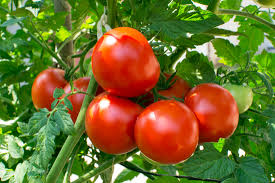
RIPED MATURED TOMATO FRUITS
STORAGE:
Tomato fruits can be stored in a dry cool place or in processed form.
I hope you have learned a few things from today’s lesson. Answer the assignment questions below and submit your answers using the form below it after supplying your name , class and E-mail address. Thank you and stay safe.
ASSIGNMENT:
State four(4) ways of preventing diseases in tomato cultivation ?
CORRECTION OF LESSON 9 ASSIGNMENT.
The term “ detuberisation “ or “ topping “ is the early harvesting of yam to produce or stimulate the production of seed yams. This practice involved cutting off the large tubers while the stems or vines are still fresh ,leaving the small heads which will eventually form the seed yams for next planting season .
DATE : 27TH JULY , 2020.
Hello students and how are you all doing? I hope you are all safe as I pray that God should continue to protect us in this trying moment.
So today , we shall be looking at – Husbandry of yam.
LESSON : 9
By the end of today’s lesson, you should be able to :
- State the ecological conditions required by yam;
- State the cultural or agronomic practices needed in yam cultivation ; and
- State the harvesting ,processing and storage of yam.
TOPIC: HUSBANDRY OF YAM .
INTRODUCTION
Yam ( Dioscorea spp ) is an important tuber crop grown in Nigeria.
VARIETIES:
There are different varieties of yam . These include :
- White yam ( Dioscorea rotundata );
- Yellow yam ( Discorea cayenensis );
- Water yam ( Discorea alata );
- Bitter yam ( Discorea domentorum );
- Aerial yam ( Discorea bulbifera);
- Chinese yam (Dioscorea esculenta).
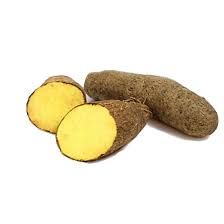
YELLOW YAM (Dioscorea cayenensis ) – A VARIETY OF YAM.
LAND PREPARATION:
Land can be cleared manually by using cutlass and ridges or heaps can be made using hoe. The land can also be prepared mechanically by using tractor ,plough and ridger to make ridges or heaps.
CLIMATIC REQUIREMENT:
- Temperature between 250C -300C is required.
- Rainfall between 100cm -180cm per annum is required.
SOIL REQUIREMENT:
A well drained sandy soil rich in humus .
METHOD OF PROPAGATION:
Yam is propagated by using yam sett or yam seeds.
SEED RATE:
One yam sett or yam seed is planted in a hole.
PLANTING DATE:
Early yam is planted between November and December while late yam is planted between March and April.
SPACING:
Spacing of yam is 90cm by 100cm or 1m by 1m.
PLANTING :
One yam sett or yam seed is placed in the ridge or heap with the cut surface turned upward and slantly placed or position at an angle of 450. This is then covered with soil.
CULTURAL OPERATIONS:
- Mulching :This is the covering of heaps or ridges with dry leaves to reduce soil temperature , conserve soil moisture and to prevent the rottening of yam sett or yam seed.
- Fertilizer application : Organic manure and NPK fertilizer can be added 3 weeks after planting.
- Weeding: Weed regularly.
- Staking: This is the placement of strong stick by the side of yam heaps or ridges for training the growing seedlings.
MATURITY PERIOD :
Maturity occurs 8 -15 months depending on the variety.
PESTS OF YAM:
- Yam tuber beetle;
- Rodents e.g . Giant rat , squirrel , cane rat etc.
DISEASES OF YAM:
- Yam mosaic disease;
- Yam rot disease;
- Yam leaf spot disease.
HARVESTING:
This is done by gently removing soil with cutlass before removing the tubers.

HARVESTED MATURED YAM TUBERS.
PROCESSING :
Yam tubers can be processed to yam flour , yam chips etc.
STORAGE:
Yam tubers are stored in barns.
I hope you have learned a few things from today’s lesson. Answer the assignment questions below and submit your answers using the form below it after supplying your name , class and E-mail address. Thank you and stay safe.
ASSIGNMENT
Explain the term “ detuberisation” in yam production ?
CORRECTION OF LESSON 8 ASSIGNMENT.
FIVE FARM EQUIPMENT USED IN PROCESSING CASSAVA.
- Grinder,
- Peeler,
- Grater,
- Dryer,
- Pressing machine.
DATE : 20TH JULY , 2020.
Hello students and how are you all doing? I hope you are all safe as I pray that God should continue to protect us in this trying moment.
So today , we shall be looking at – Husbandry of cassava.
LESSON : 8
By the end of today’s lesson, you should be able to :
- State the ecological conditions required by cassava;
- State the cultural or agronomic practices needed in cassava cultivation ; and
- State the harvesting ,processing and storage of cassava.
TOPIC: HUSBANDRY OF CASSAVA .
INTRODUCTION
Cassava ( Manihot spp ) is an important tuber crop grown in Nigeria. It has underground roots which can be consumed by man and livestock after processing .
VARIETIES:
There are two main varieties of cassava ; namely ;
- Sweet cassava (Manihot palmata ),
- Bitter cassava (Manihot utilissima ) which contains poisonous hydrocyanic acid in its roots.
LAND PREPARATION:
Land can be cleared manually by using cutlass and ridges or heaps can be made using hoe. The land can also be prepared mechanically by using tractor ,plough and ridger to make ridges.
CLIMATIC REQUIREMENT:
- Temperature between 210C -350C is required.
- Rainfall between 150cm -200cm per annum is required.
SOIL REQUIREMENT:
A well drained rich loamy soil is required.
METHOD OF PROPAGATION:
Cassava is propagated by stem cuttings.
PLANTING DATE:
The planting date for cassava is march – September.
SPACING:
Spacing of cassava is 1m by 1m.
PLANTING :
Cassava stem of 25 -30 cm long is inserted into the ridge or heap in slanting position at an angle of 450. The stem is inserted in such a way that 2/3 of the stem is buried and the buds facing upward.
GERMINATION:
Sprouting from the buds occurs 7 – 14 days after planting.
CULTURAL OPERATIONS:
- Fertilizer application : Organic manure and NPK at 250kg/ha. Can be added 4 – 6 weeks after planting.
- Weeding: Weed regularly.
MATURITY PERIOD :
Maturity occurs 6 – 15 months depending on the variety.
PESTS OF CASSAVA:
- Variegated grasshopper,
- Rodents e.g . Giant rat , squirrel , cane rat etc.
DISEASES OF CASSAVA:
- Angular leaf spot,
- Bacterial blight,
- Cassava mosaic disease.
HARVESTING:
Cassava is harvested by using cutlass to remove some soil above the tubers and pull the stem gently so that the tubers are pulled along. It can also be done mechanically using the cassava puller.
PROCESSING :
Cassava is processed into garri , cassava flour , cassava flakes ,starch etc.
STORAGE:
It is stored in processed form in sacks or silos.
I hope you have learned a few things from today’s lesson. Answer the assignment questions below and submit your answers using the form below it after supplying your name , class and E-mail address. Thank you and stay safe.
ASSIGNMENT
Mention five(5) farm equipment used in the processing of cassava ?
CORRECTION OF LESSON 7 ASSIGNMENT.
REASON FOR PREVENTING BEAN WEEVILS INFESTATION ON COWPEA DURING STORAGE.
To prevent poor quality of cowpea seeds during marketing.
To prevent reduced viability of seeds.
FOUR AGRONOMIC PRACTICES NEEDED IN COWPEA PRODUCTION.
Regular weeding;
Early planting;
Early harvesting;
Thinning
DATE : 13TH JULY , 2020.
Hello students, is nice reaching out to you once again.How are you all doing? I hope you are all safe as I pray that God should continue to protect us in this trying moment. Now that we are done with the third term scheme of work, subsequent lessons shall be on the husbandry of important crops grown in Nigeria.
Today’s lesson is going to be as interesting as the previous one . So today , we shall be looking at – Husbandry of cowpea.
LESSON : 7
By the end of today’s lesson, you should be able to :
- State the ecological conditions required by cowpea;
- State the cultural or agronomic practices needed in cowpea cultivation ; and
- State the harvesting ,processing and storage of cowpea.
TOPIC: HUSBANDRY OF COWPEA .
INTRODUCTION
Cowpea ( Vigna sinensis or V. unguiculata ) or bean as it is popularly called is local or indigenous to West Africa where it spreads to other parts of the world like West Indies through the Spanish settlers. It is used as food by man and his livestock. It belongs to the family called leguminosae and is rich in plant protein. The fruit of cowpea is known as pod.
VARIETIES:
- Ife brown;
- Ife bimpe;
- Kano white;
- Umudike brown;
- Ibadan brown.
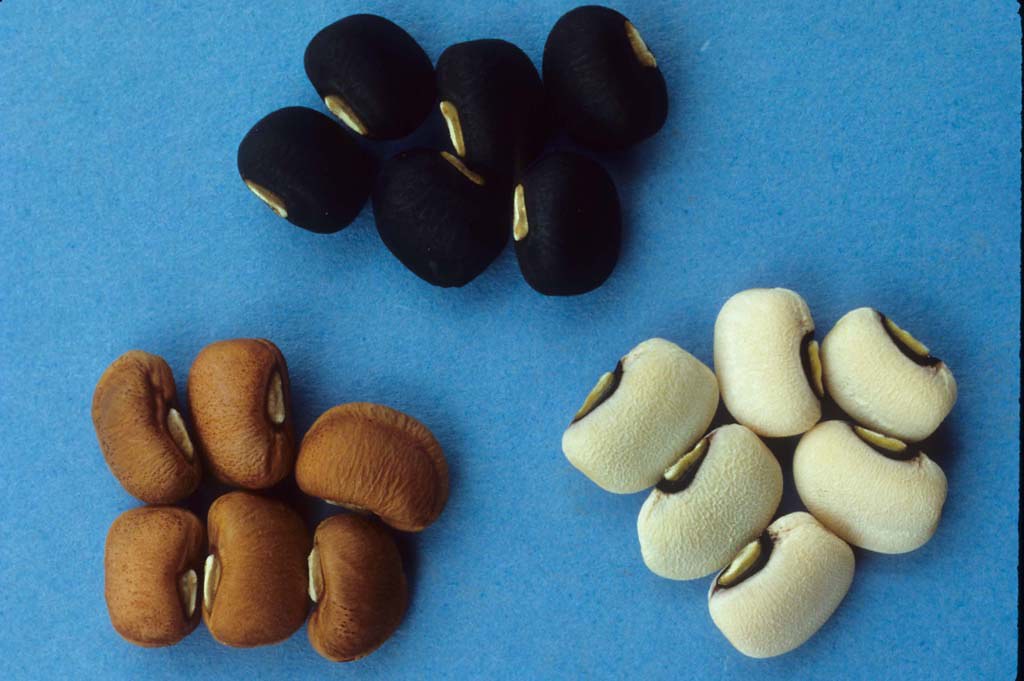
VARIETIES OF COWPEA.
LAND PREPARATION:
- Manually by hoe and cutlass.
- Mechanically using tractor , plough , harrow and ridger.
CLIMATIC REQUIREMENT:
- Temperature between 270C -350C.
- Rainfall between 75cm -152cm per annum.
SOIL REQUIREMENT:
A rich sandy-loamy soil is required.
METHOD OF PROPAGATION:
Cowpea is propagated by seeds.
PLANTING DATE:
In the south, early planting of cowpea is April and late planting is August or September.In the north , late planting is July and August.
SPACING:
Spacing for erect type variety is 30cm by 75cm and the spacing for the spreading type is 25cm by 90cm.
SEED RATE:
Two to three seeds are planted in a hole of 2 – 4cm deep.
GERMINATION:
Germination occurs 3 -5 days after planting.
CULTURAL OPERATIONS:
- Thinning: This is done about 2 – 5 weeks of age after planting.
- Fertilizer application : This should be applied at land preparation or at planting. Phosphatic fertilizer should be added for nodulation and pod formation.
- Weeding: Weeding is done once or twice by using cutlass , hoe ,or by applying chemicals . e.g herbicides.
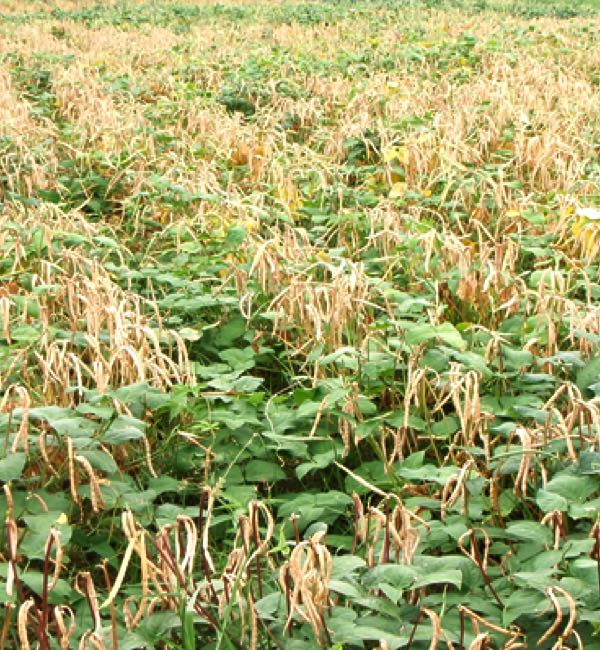
MATURED COWPEA PODS READY FOR HARVEST ON THE FIELD.
PESTS OF COWPEA:
- Pod borers;
- Bean beetle;
- Bean weevils;
- Leaf hopper;
DISEASES OF COWPEA:
- Damping off disease;
- Bacterial blight;
- Nematode disease.
- Cowpea mosaic disease;
MATURITY PERIOD:
Cowpea matures between 3 – 4 months after planting .
HARVESTING:
It is done by hand picking .
PROCESSING AND USES:
- Harvested pods are dried under the sun .
- Shelling is carried out . This could be done by pounding the pods lightly in a mortal or by beating with sticks .
- Winnowing is carried out to remove the broken shell from the beans.
STORAGE:
The seeds are stored in silos , jute bags or air tight containers.
I hope you have learned a few things from today’s lesson. Answer the assignment questions below and submit your answers using the form below it after supplying your name , class and E-mail address. Thank you and stay safe.
ASSIGNMENT
- State two (2) reasons why bean weevils should be prevented from infesting cowpea during storage?
- Mention four(4) agronomic practices needed in the growing of cowpea in Oyo State?
CORRECTION OF LESSON 6 ASSIGNMENT.
- FIVE AGRO-BASED INDUSTRIES THAT USE MAIZE AS MAJOR RAW MATERIAL.
Flour mill.
Feed mill.
Starch industry.
Beverage industry.
Bio fuel industry.
TWO FIELD PESTS OF MAIZE
- Grasshopper;
- Maize stem borer.
TWO STORE PESTS OF MAIZE
- Maize weevil.
- Rat.
DATE : 6TH JULY , 2020
Hello students, is nice reaching out to you once again.How are you all doing? I hope you are all safe as I pray that God should continue to protect us in this trying moment.
Today’s lesson is going to be as interesting as the previous one . So today , we shall be looking at – Husbandry of maize.
LESSON : 6
By the end of today’s lesson, you should be able to :
- State the ecological conditions required by maize;
- State the cultural or agronomic practices needed in maize cultivation ; and
- State the harvesting ,processing and storage of maize.
TOPIC: HUSBANDRY OF MAIZE .
INTRODUCTION
Maize ( Zea mays ) , which is also known as corn , is a member of the grass family called graminaceae .It is native to tropical America and widely grown in Nigeria and other West Africa countries like Ghana ,Sierra Leone etc. It is an annual crop with a height of between one to three meters depending on the variety.
VARIETIES:
- Sweet corn ;
- Pop corn;
- Flint corn;
- Dent maize;
- Flour maize.
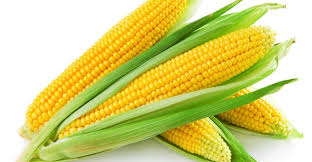
SWEET CORN – A VARIETY OF MAIZE.
LAND PREPARATION:
- Manually by hoe and cutlass.
- Mechanically by ploughing , harrowing and ridging.
CLIMATIC REQUIREMENT:
- Temperature between 260C -300C.
- Rainfall between 75cm -150cm per annum.
SOIL REQUIREMENT:
A well drained sandy-loam soil of PH of about 6 -7.
METHOD OF PROPAGATION:
Maize is propagated by seeds in two ways:
- Manually using stick or small knife.
- Mechanically using machine called planter.
PLANTING DATE:
Planting date of maize depends on location and rainfall.
Early maize is planted between March – April. Late maize between July – August.
SPACING:
Spacing of 90cm by 60cm is required if two seeds is planted in a hole. A spacing of 75cm by 25cm if one seed are planted in a hole.
SEED RATE:
Two to three seeds are planted in a hole of 2 – 4cm deep.
GERMINATION:
Germination occurs 4 -7 days after planting.
CULTURAL PRACTICES:
- Thinning: This is the removal of weak plant from growing seedlings to give rise to one or two per stand.
- Supplying: This is the replanting of maize seeds to replace the seed that do not germinate.
- Fertilizer application : Organic manure such as poultry droppings , animal dung , farm yard manure or inorganic fertilizers. E.g NPK 15:15:15 can be added 5 – 6 weeks after planting.
- Weeding: Weeding can be done manually by using hoe or chemically by using specified herbicide. Weeding is done 3 – 4 times at regular intervals.
CONTROL OF PESTS AND DISEASES: Pest and disease control is done anytime at regular intervals by using chemical.
PESTS OF MAIZE:
- Maize weevil.
- Grasshopper.
- Stem borer.
DISEASES OF MAIZE:
- Leaf spot.
- Maize rust.
- Maize smut.
MATURITY PERIOD:
Maize matures between 3 – 4 months . Wet maize matures at 3 -4 months while the dry maize matures below 3 -4 months.
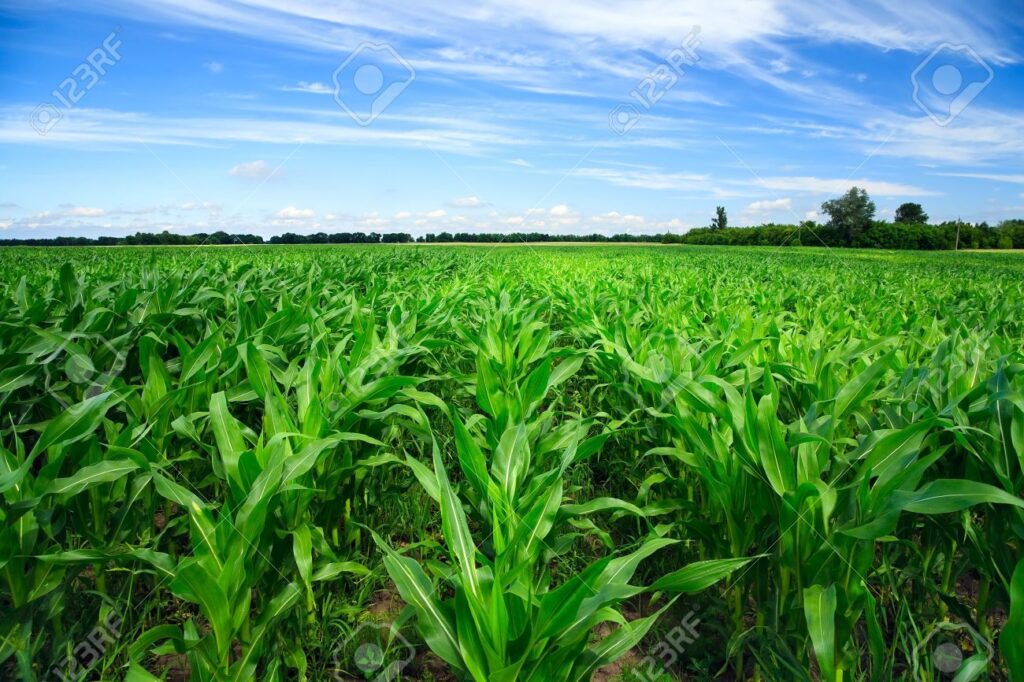
A MAIZE PLANTATION.
HARVESTING:
Maize is harvested when the silk at the head of the cob dries by hand , sickle or combined harvester.
PROCESSING AND USES:
Maize can be processed into corn flakes .corn flour ,raw pap ,livestock feed , beer, baking flour. It can be eaten boiled or roasted.
STORAGE:
Maize grains can be stored in silos, cribs, rhombus or fire places.
I hope you have learned a few things from today’s lesson. Answer the assignment questions below and submit your answers using the form below it after supplying your name , class and E-mail address. Thank you and stay safe.
ASSIGNMENT
- Mention five(5) agro-based industries where maize is a major raw material ?
- Mention two(2) field and two(2) store pests of maize each in Nigeria ?
CORRECTION OF LESSON 5 ASSIGNMENT.
- CROPS THAT ARE BOTH ANNUAL AND EPHEMERAL
a. Maize;
b. Cowpea;
c. Tomato;
d. Okra.
CROPS THAT ARE BOTH ROOT CROP AND VEGETABLE CROP
a. Carrot;
b. Sugar beet or beet root.
DATE : 29TH JUNE , 2O2O.
Hello students, glad to know you are there. The idea behind today’s lesson is to show you how agricultural crops are classified . Hopefully , after this lesson , you will have a better understanding of the various ways crops are grouped.
.LESSON : 5
By the end of today’s lesson, you should be able to :
- Classify crops based on life cycle;
- Classify crops based on morphology and;
- Classify crops based on uses.
TOPIC: CLASSIFICATION OF CROPS.
INTRODUCTION
A plant grown by man to provide useful substance or substances is called a crop. Of all the historical eras of agriculture , Neolithic era, the new stone age , witness a settled life for man as cultivation and domesticaton of animals began in this period leading to the abandonment of fruit gathering and collection to various cropping and farming systems practiced till date.
These numerous crop plants grown by man are , therefore , classified into groups due to similar properties that they shared.
Now let’s start this way:
Classification of crops refers to the order or group of crops with identical features. Crops can ,therefore , be classified based on the following:
- Life cycle;
- Morphology;
- Uses.
CLASSIFICATION OF CROPS BASED ON LIFE CYCLE
Based on life cycle, crops can be classified as :
- Annual crops ,i.e, crops that grow , mature and die in one year.e.g Rice ,Yam etc.
- Biennial crops ,i.e , crops that grow, mature and die within two years , e.g Plantain ,Onion , Cabbage etc.
- Perennial crops ,i.e, crops that grow , mature and complete their life cycle in more than two years. E.g ,Mango , Oilpalm ,Rubber ,Citrus etc .
- Ephemeral crops ,i.e., crops that grow , mature and. e.g ,complete their life once in three or months , e.g Okra , Water leaf etc.
CLASSIFICATION OF CROPS BASED ON MORPHOLOGY
Under this classification, crops are divided into two groups based on the number of cotyledon or seed leaf . These are:
- monocotyledonous plants;
- dicotyledonous plants.
MONOCOTYLEDONOUS PLANTS: These are crops whose seeds have one cotyledon or seed leaf . e.g Maize , rice , wheat ,sorghum ,millet ,sugarcane etc.
DICOTYLEDONOUS PLANTS: These are crops whose seeds have two cotyledons or seed leaves. e.g Soyabean , melon ,groundnut , cowpea etc.
CLASSIFICATION OF CROPS BASED ON USES
Based on economic uses ,crops are classified into the following :
- Cereal crops :These are crops that produce small grains which are rich in carbohydrates. e.g Maize , rice, millet , wheat etc.
- Legume (Pulse ) crops: These are crops whose seeds serve as source of protein. e.g Cowpea , melon, soyabean , groundnut etc.
- Tuber crops : These are crops whose edible parts are swollen roots or underground stems. e.g Yam , cassava, cocoyam etc.
- Fiber crop : These are crops whose fruits or some other parts are processed into clothing materials and ropes.e.g Cotton , jute ,sisal etc.
- Vegetable crops :These are crops whose leaves , fruits and other parts can be eaten. e.g Lettuce ,okra , tomato etc.
- Beverage crops : These are crops whose products are processed into food drinks.e.g Cocoa , kola, coffee, tea etc.
- Fruit crops :These are crops whose fruits are either eaten raw or cooked.e.g Mango , guava, orange etc.
- Oil crops :These are crops whose seeds are processed to produce oil for both domestic and industrial uses. e.g Oilpalm , groundnut, coconut etc.
- Latex crops:These are crops produce a milky sap called latex used in the production of rubber materials.e.g Rubber .
- Spice crops :These are crops used for adding flavor to our food in order to improve their tastes.e.g Onion , ginger ,garlic etc.
- Forage crops:These are crops grown primarily for feeding farm animals. e.g Elephant grass ,centrosema , guinea grass etc.
- Drug crops :These are crops grown for their medicinal values. e.g Tobacco , kola etc
- Ornamental crops :These are crops grown for the purpose of beatifying our homes and surroundings .e.g Hibiscus , rose , queen of the night etc.
I hope you have learned a few things from today’s lesson. Anwser the assignment questions below and submit your answers using the form below it after supplying your name , class and E-mail address. Thank you and stay safe.
ASSIGNMENT
- Mention four (4) crops that are both annual and ephemeral ?
- Mention two(2) crops that are classified as both root crop and vegetable crop?
CORRECTION OF LESSON 4 ASSIGNMENT.
ADVANTAGES OF USING FARM MACHINERY ON THE FARM.
- There will be increase in farm size.
- There will be increase in efficiency of production.
- Farm work will be less tedious.
- Farm operations are accomplished with speed.
- Some farm operations can be combined into one .e.g use of combined harvester for heading ,threshing and winnowing at the same time.
REASONS FOR MAINTAINING FARM MACHINERY.
- To prevent rusting of metal parts.
- To enable machines to continue to function well.
- To prevent breakdown of machines during operation
DATE : 22ND JUNE , 2O2O.
Hello students, glad to know you are there. The idea behind today’s lesson is to show you what farm machinery and implements are on the farm . Hopefully , after this lesson , you will have a better understanding of the various agricultural machinery; what they are used for as well as how they are maintained on the farm.
LESSON : 4
By the end of today’s lesson, you should be able to :
- Define farm machinery;
- Describe the farm tractor and some tractor- coupled implements and their functions and;
- Recognize the different types of farm machines and equipment.
TOPIC: FARM MACHINERY AND IMPLEMENTS.
INTRODUCTION
The provision of modern farming conveniences such as electicity ,pipe-borne water ,machinery etc make farming less stressful. This has made man from being a power source to a manager of power and consequently, improved farming operations.
Farm machinery , that is , a group of agricultural or farm machines are either classified as barn (shed) machines because of their location in sheds for various post-harvest activities ( e.g grinders ,shellers ,dryers etc ) or field machines because of their usage on the field for various field operations ( e.g tractors ,harrows (cultivators), planters etc.)
The most important farm machine on the farm is the farm tractor or tractor as it used for operating many farm machines since most farm machines are useless without power to run them.
Now let’s get started this way:
MEANING OF FARM MACHINERY.
Farm machinery refers to various machines and implements powered to carry out farm operations for improved agricultural production. e .g farm tractor , bulldozer , tree puller , plough , harrow , incubator ,sprayer ,sheller , iirigation pump etc. Some of the operations carried out in the farm using these machines include clearing , seed bed preparation ,planting ,weeding ,spraying ,harvesting ,threshing ,milling etc.
TYPES OF FARM MACHINERIES.
There are two (2 ) types of farm machinery and implements: namely ;
- Barn (Shed ) machines , i. e , machines located in a shed . e.g sheller , grinder ,dryer etc.
- Field machines , i.e , machines that are used on the field for various field operations. e.g tractor , ridger , harvester ,plough etc.
CLASSIFICATION OF FARM MACHINERY.
Farm machines and implements are again classified into two ; namely ;Based on size of machine, we have,
Hand-driven machines , i.e , small machines that can be pushed by man. E.g Hand operated planter or Flexi-planter.
Animal-driven machines , i.e , medium-sized machines pulled by oxen or bullock , e.g Animal-driven mould board plough.
Power-driven machines , i.e , heavy machines powered by petrol or diesel , e.g , Bulldozer , Tree –puller, Tractor,
Based on source of power ,we have,
Trailed implements , i.e , machines with their own support wheels but derives power from the tractor.
Semi-mounted implements , i.e , machines with their own support wheels , mounted to and derive power from the tractor.
Mounted implements, i.e , machines with no support wheels and totally carried by the tractor and derive power from the tractor hydraulic system.
Seif-propelled implements ,i.e , machines with their own in-built power source.
THE FARM TRACTOR.
A tractor is a powerful and expensive multi-purpose farm machine on two or four wheels used for performing many farm operations both mobile and stationary .It is the basic source of power on a mechanized farm.It consists of an internal combustion engine and a hydraulic system used for lifting or pulling farm implements like plough , harrow , ridger etc.
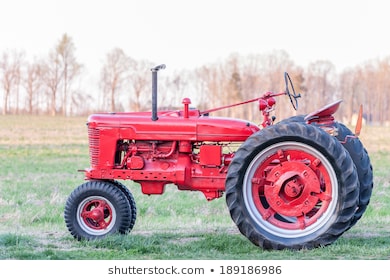
A TYPICAL FOUR-WHEEL FARM TRACTOR
TYPES OF TRACTORS
Tractors are grouped into three(3) categories or types based on :
- Engine type as :
(a). Injection or diesel engine tractor.
(b). Petrol engine tractor.
- Wheel or tyre type as :
(a). Pneumatic (rubber) tyre tractor.
(b). Crawler(chain) tyre tractor,
(c). Half-track tyre tractor.
- Engine capacity or power output type as :
(a). Small tractor.
(b). Medium tractor.
(c). Large tractor.
PARTS OF A TRACTOR.
- Tractor engine – for generating power derived from the burning of fuel.
- Wheels – to provide the means of traction or movement.
- Hydraulic system – for lifting and lowering mounted implements.
- Back linkage device – for mounting some farm implements.
- Draw bar – for hooking farm implements to be drawn.
- Power-Take-Off (P-T-O) Shaft- for transmitting power to some attached implements.
USES (FUNCTIONS) OF THE TRACTOR.
(a). For transporting farm inputs and outputs.
(b). For transporting farm workers.
(c). For pulling farm implements e.g plough , harrow . ridger etc.
(d). For propelling farm equipment e.g mower.
DAILY MAINTENANCE OF A TRACTOR.
- Check the oil level before use.
- Check the radiator water level before use.
- Check and maintain battery electrolyte level.
- Check the tyre pressures.
- Gauge the fuel level before use.
ROUTINE(PERIODIC) MAINTENANCE OF A TRACTOR.
- Weld broken parts.
- Replace worn out parts.
- Lubricate movable joints or parts regularly.
- Tighten loose bolts and nuts .
- Ensure functional brakes.
- Change spark plugs where applicable.
TRACTOR-COUPLED (INTERMEDIATE) IMPLEMENTS
Tractor-coupled or tractor-mounted implements can be defined as implements or equipment which are attached or coupled to a tractor in order to enable them perform their works or functions. These are also refer to as intermediate farm implements and they include:
(a). tillage implements;
(b), spraying equipment;
(c).planting equipment;
(d).harvesting implements.
TILLAGE IMPLEMENTS :These are equipment used for tilling the soil in order to create optimum condition for crop growth. E . g plough , cultivator , harrow , ridger ,roller etc.There are two(2) types of soil tillage. These are :
- Primary tillage: Thisis intial break up of the soil during land preparation and the main implement used is the plough.
- Secondary tjllage: This refers to all other land preparation activities carried out to break down soil lumps obtained from primary tillage and prepare a suitable seed bed for planting crops.The implements needed for this include harrow ( cultivator) , ridger ,roller etc.
PLOUGH : This is the first primary tillage implement for soil cultivation driven by tractor or work animals. Parts of a plough include beam or frame , hinge or coupling point ,scrapper , linkage point , disc ,wheel , share, handle ,coultier etc. E. g Disc plough , Mould board plough.

DIAGRAM OF AN ANIMAL-DRIVEN MOULD BOARD PLOUGH.
USES OF PLOUGH
- Used to bite or cut the soil and turn it over to form soil clods or lumps.
- Used to control weeds.
- Helps in mixing soil together.
- For improving water – infiltration capacity.
HARROW: This is used for secondary tillage where soil clods left during primary tillage are broken down into fine particles before planting . Important parts of a harrow include handle , steel disc ,draw-bar ,scrapper ,wheel etc. e. g.Disc harrow ,Springtine (Springtooth) harrow and Spike-tooth harrow.
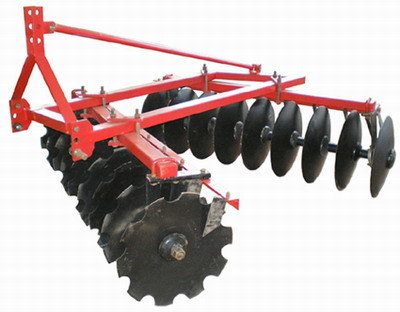
A DISC HARROW
USES OF HARROIW
- It is used to break large soil clods after ploughing.
- It is used to remove weed from soil surface , i.e, raking.
- It is used to drag roots and stones out of soil.
- Used to stir the soil without turning it over ,i. e, pulverization.
RIDGER:This is used for collecting rich top soil together to form ridges before planting and after harrowing. Important parts of a ridger include beam ,coultier , scrapper , coupling point etc . E .g Disc ridger , Mould board ridger.
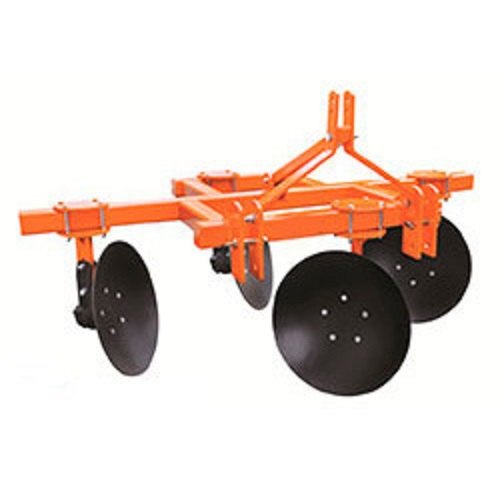
A DISC RIDGER.
USES OF RIDGER
- It is used for making ridges.
- Used to prevent weed growth.
- Used to facilitate harvesting of some root crops ,e.g, Groundnut, Carrot etc.
- To control soil erosion .
SPRAYING EQUIPMENT :These equipment are designed to spray certain chemicals on crops and livestock in various farm operations. e .g Handgun sprayer , knapsack sprayer , Motorized sprayer ,Tractor-mounted sprayer ,Helicopter-mounted (Aircraft) sprayer.
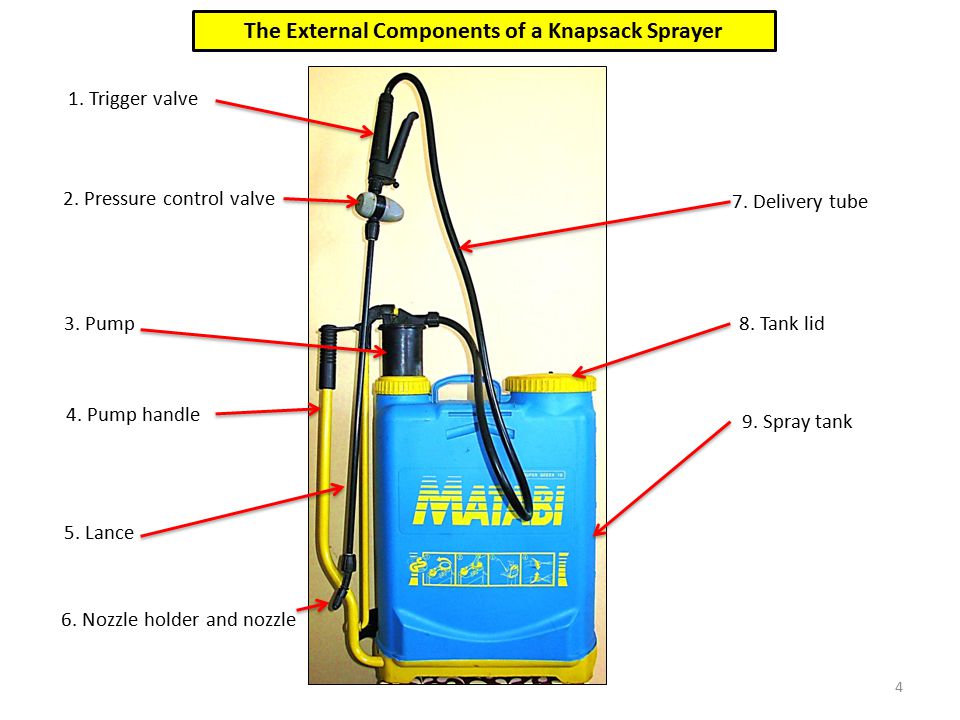
USES OF SPRAYER
- For spraying herbicides to check weeds.
- For controlling insect pests using insecticides.
- For applying disinfectants on livestock houses and structures.
- It is also used for light irrigation especially on vegetable beds.
PLANTING EQUIPMENT : These are equipment used for depositing seeds or other vegetative parts of plants in the soil in such a manner that will ensure their proper germination. A planter basically consists of a hopper , a furrow opener ,a seed meter ,a furrow covering device and a roller. E. g , Row (Precision) planter , Seed drill , Broadcaster.etc.
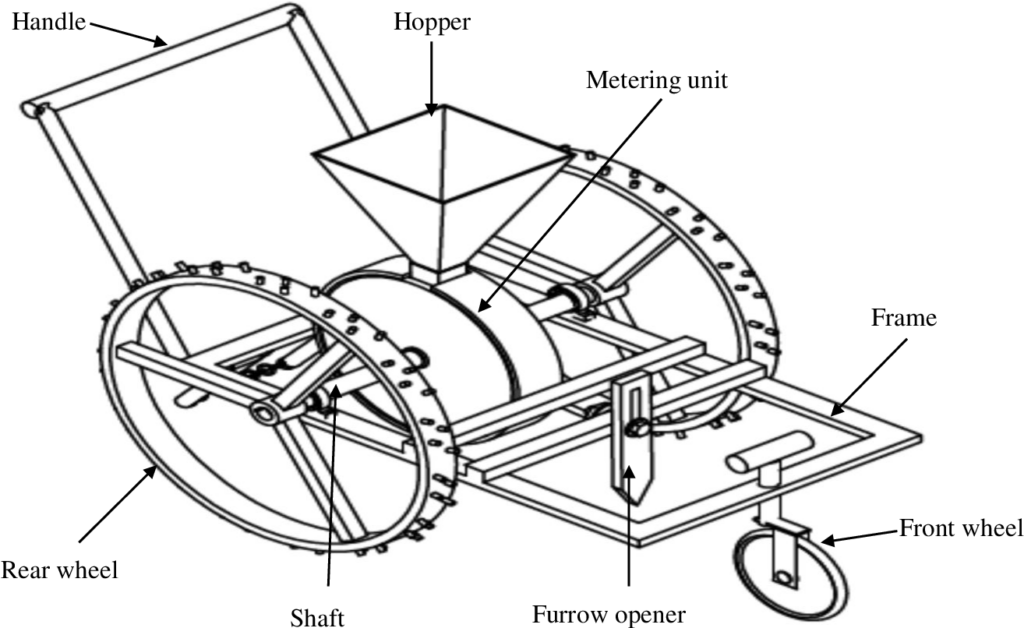
DIAGRAM OF A HAND-DRIVEN PLANTER.
HARVESTING EQUIPMENT :These equipment are used primarily to facilitate the process of harvesting various crops such as grains , tubers and tree crops. E.g Mower , Forage harvester , Hay baler , Combined harvester .
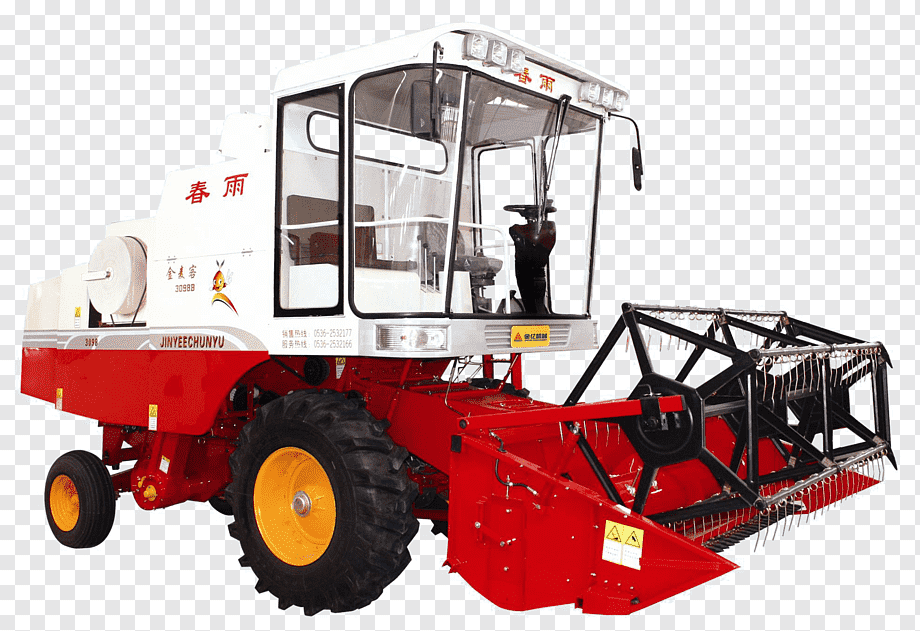
A COMBINED HARVESTER.
SOME PROCESSING EQUIPMENT ON THE FARM.
| S/NO | EQUIPMENT | USAGE |
| 1 | SHELLER | For detaching seeds from pods. |
| 2 | THRESHER | For removing husks from grains. |
| 3 | DRYER | To lower moisture content of crop and livestock products to desire level. |
| 4 | GRINDER | For crushing crops to powder or slurry when dry or wet respectively. |
| 5 | MILL | For large grinding operations. |
| 6 | GRATER | For converting tubers into mash or pulp form. |
| 7 | BLOWER(WINNOWER | For blowing chaff from grains , i.e , winnowing. |
| 8 | MILKING MACHINE | For expelling milk from dairy animals. |
WAYS OF MAINTAINING FARM MACHINERY
(a). Use competent persons to rectify faults found on machines.
(b). Paint necessary parts or panels.
(c). Clean and grease moving parts of machines.
(d). Use the right implement for the right operation.
(e). Ensure complete coupling on all the points before operation.
(f). Remove wheels of machines during long storage.
I hope you have learned a few things from today’s lesson. Answer the assignment questions below and submit your answers using the form below it after supplying your name , class and E-mail address. Thank you and stay safe.
ASSIGNMENT
- State five(5)advantages of using farm machinery on the farm?
- Mention three(3) reasons for maintaining farm machinery?
CORRECTION OF LESSON 3 ASSIGNMENT.
LIMITATIONS TO FARM MECHANISATION IN OYO STATE.
- High cost of spare parts for machines.
- Inadequate expertise that can handle imported machines.
- Small farm holdings of most local farmers.
- Poor financial status of most farmers.
- Dense vegetation problems or stumps.
PROSPECT S OF FARM MECHANISATION IN NIGERIA
- Government should provide subsidies for farmers to purchase machines needed.
- Banks should give enough capital to serious farmers.
- Farmers should be educated on the use of modern farming technologies.
- More personnel should be trained on how to repair and maintain farm machines.
- Farmers’ co-operative societies should pool their resources together to procure modern equipment.
DATE: 15TH JUNE 2020.
Hello students, glad to know you are there. Welcome to today’s lesson. In this lesson ,we will discuss a simple topic—- “ Agricultural Mechanisation “ or “ Farm Mechanisation “. I hope , after this lesson , you will have a better understanding of what farm mechanization is all about.
LESSON : 3
By the end of today’s lesson, you should be able to :
- Define agricultural mechanisation;
- Mention some merits and some demerits of farm mechanisation ; and
- State some problems of agricultural mechanization in Nigeria.
TOPIC: AGRICULTURAL MECHANISATION.
INTRODUCTION
Before the introduction of farm machines, farm work was mainly done by the use of simple farm tools. These tools usually make work uninteresting and unproductive.
Mechanisation has made modern farming attractive to young farmers , reduced drudgery and back breaking in farming and quickened farm operations leading to high quality and quantity production.
DEFINITION.
Agricultural mechanization can be defined as the application of engineering and technological principles in the production . processing and storage of agricultural produce on the farm.
ADVANTAGES OF FARM MECHANISATION.
- Farm mechanization reduces drudgery , i. e , tedious nature of farm work.
- It increases agricultural output.
- It increases farm revenue.
- It saves time.
- It encourages specialization.
- It enables farmers to cultivate large hectares of land.


SOME DRUDGERY REDUCTION FARM MACHINES.
DISADVANTAGES OF FARM MECHANISATION.
- It encourages deforestation.
- It is expensive due to high cost of machines and other inputs.
- Displacement of unskilled workers. e.g Farm labourers.
- Use of heavy earth moving machinery can lead to soil compaction. e.g Bulldozers ,Tractors etc.
- It can also cause environmental pollution .e.g Exhaust (fumes) from farm machines , agrochemicals .
- Heavy usage of farm implements can lead to soil structure destruction.
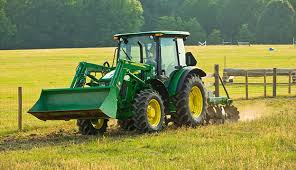
A SOIL COMPACTION AND POLLUTION INDUCED HEAVY MACHINERY.
Now that you know what farm mechanization is , its benefits as well as its demerits; let us look at some of the problems facing farm mechanization and possible solutions in Nigeria:
PROBLEMS OF AGRICULTURAL MECHANISATION IN NIGERIA.
- Exhorbitant cost of hiring machines. e.g Tractor ,Bulldozer etc.
- High cost of maintenance e.g Irrigation facilities.
- Inadequate trained personnel.
- Land tenure system in Nigeria.
- High cost of spare parts for machines.
- Poor status of most rural farmers.
- Lack of technical-know-how , i.e , expertise.
SOLUTIONS TO PROBLEMS OF FARM MECHANISATION IN NIGERIA.
- Government should assist the farmers by giving out loans to purchase farm machines.
- Farmers should form co-operative societies to buy farm equipment jointly.
- Land tenure system should be amended for easy land acquisition.
- Simple and less expensive machines should be developed for farmers.
I hope you have learned a few things from today’s lesson. Answer the assignment questions below and submit your answers using the form below it after supplying your name , class and E-mail address. Thank you and stay safe.
ASSIGNMENT
- State five(5) limitations to farm mechanization in Oyo State?
- Mention five(5) prospects of farm mechanization in Nigeria?
CORRECTION OF LESSON 2 ASSIGNMENT.
DIFFERENCES BETWEEN WEST AFRICAN HOE AND WEST INDIAN HOE.
1.The West African hoe has a short handle while The West Indian hoe has a long handle.
2.The West African hoe has a round metal blade while The West Indian hoe has a rectangular metal blade.
IMPLICATIONS OF USING SIMPLE FARM TOOLS IN A COMMERCIAL FARM.
- Simple farm tools reduce farm productivity.
- They consume or waste time and energy.
- They can cause reduction in farm revenue.
Hello students, glad you are there.Today , I am not just going to teach you what simple farm tools are and I am also going to explain to you the various ways we can deploy them on the farm.
LESSON : 2
By the end of today’s lesson, you should be able to :
- Explain the meaning of simple farm tools;
- Identify various types of simple farm tools ; and
- State their uses and general maintenance.
TOPIC: SIMPLE FARM TOOLS.
INTRODUCTION
Work done on the farm are through the use of one tool or implement of some kind. These tools are simple in nature and are usually made of metals and woods joined together. They are usually used by small scale farmers due to their simple and primitive nature.
Now let us look at what simple farm tools are and their functions:
MEANING OF SIMPLE FARM TOOLS.
Simple farm tools can be defined as devices which are manually used to perform various farm operations. They are simple , handy tools used mainly by peasant farmers. E.g Hoe, Cutlass , Mattock , Rake etc.
TYPES OF SIMPLE FARM TOOLS AND THEIR USES.
| S/NO. | SIMPLE FARM TOOL. | USES. |
| 1 | HOE | Weeding , Harvesting ,Land preparation. |
| 2 | CUTLASS | Tree felling , Land clearing , Harvesting , Planting. |
| 3 | HAND FORK | Breaking of soil clods , Working manure into soil. |
| 4 | FILE | Sharpening of metal blades. |
| 5 | SHEARS | Pruning ,Trimming of flower hedges. |
| 6 | HAND TROWEL | Transplating seedlings , Weeding of vegetable beds. |
| 7 | RAKE | Gathering cut plant materials for burning ,Harrowing. |
| 8 | WATERING CAN | Light irrigation ,temporary storage of water. |
| 9 | WHEEL BARROW | Carrying farm inputs and outputs in and out of the farm. |
| 10 | GARDEN FORK | Turning compost ,Working manure into soil. |
| 11 | SPANNER | Loosening and tightening bolts and nuts. |
| 12 | SECATEURS | Budding operation , Pruning tree crops and flowers. |
| 13 | AXE | Felling trees. Cutting stumps and roots of large trees. |
| 14 | MATTOCK | Stumping ,Removal of tree roots. |
DIAGRAMS AND DESCRIPTION OF SOME SIMPLE FARM TOOLS.
(a). CUTLASS: This tool has a short wooden or plasic handle and a long metal blade with two edges. One edge is sharp and the other blunt .The sharp edge is used for cutting ,weeding , harvesting and planting.
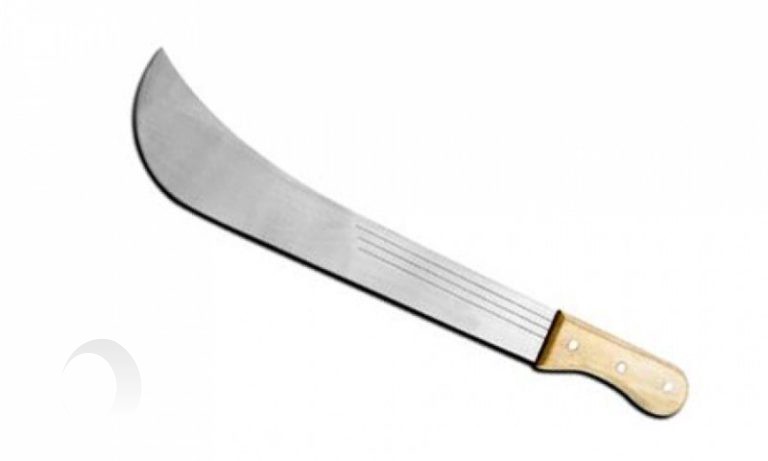
(b). HOE: The hoe is a tool with a short or long wooden or metal handle and a flat rectangular or round metal blade fitted to it for making ridges ,tilling of soil , harvesting and weeding. There are two types of hoes ; namely ; The West Indian hoe and The West African hoe.
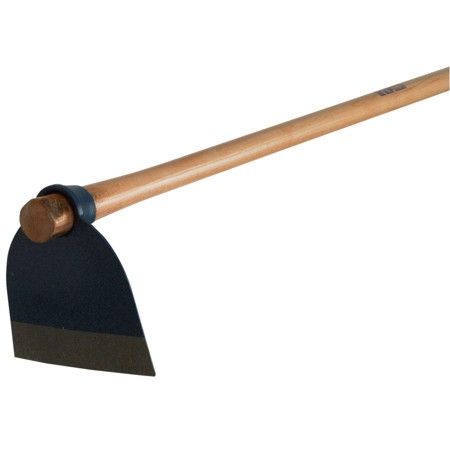
(c). AXE : This consists of o thick metal blade a fairly long wooden or metal handle.The blade is either triangular or rectangular in shape with the sharp edge used for felling trees.
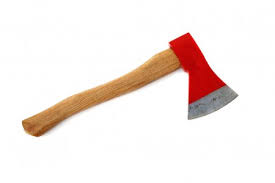
(d). GARDEN FORK : This has four metal prongs and a long wooden handle with a D-shaped handle.It is used for loosening and scattering manure.

(e). HAND TROWEL: This tool consists of a curved heart-shaped or hollow-shaped metal blade with a short wooden or metal handle. It is also known as garden trowel though smaller than the shovel and can be used for light digging , soil mixing and transplanting of seedlings.
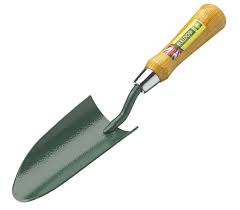
(f).HAY FORK: This tool has a T-shaped handle and a U-shaped metal head.The U-shape is split into two pin-like structures used for lifting hay in the hay house when feeding farm animals.
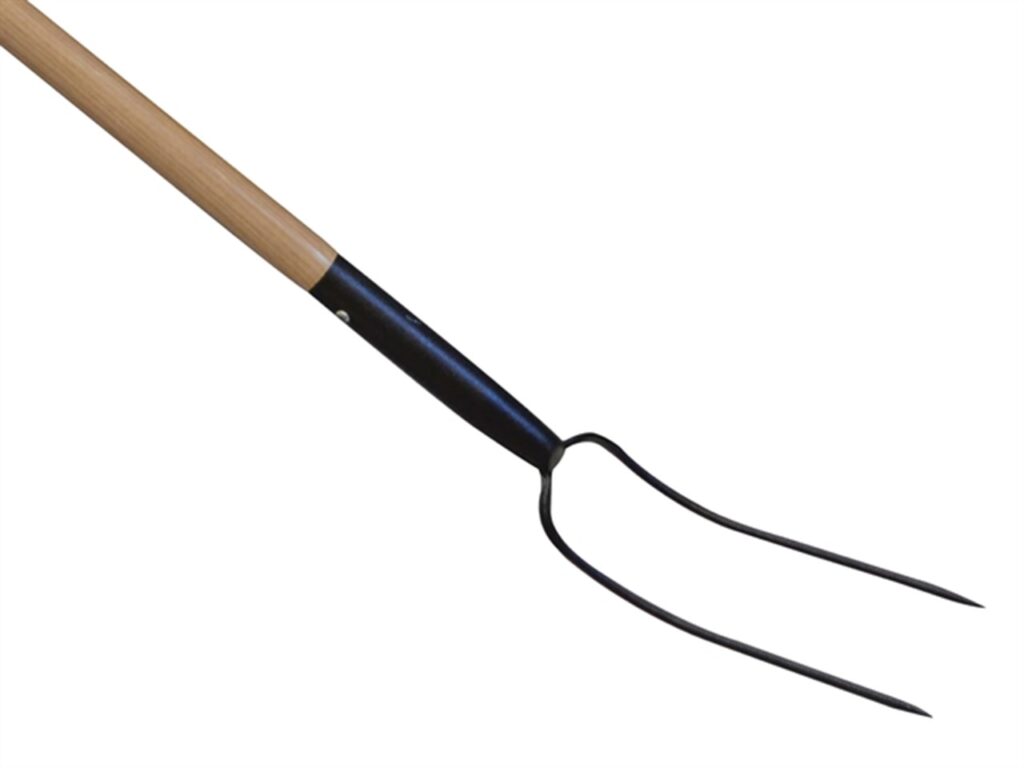
It is important to note that these tools , like every other material , on the farm should be preserved or protected to prolong their shelve-life or life span ,hence , the need to maintain them. Here are some of the ways simple farm tools can be maintained :
GENERAL MAINTENANCE OF SIMPLE FARM TOOLS.
- Store tools in a cool dry place after use.
- Sharpen blunt edges or blades where necessary.
- Oil ,grease or lubricate movable joints to reduce friction.
- Paint wooden parts to prevent termite attack.
- Wash and clean properly after use.
- Paint , oil or grease metallic parts against rusting.
- Tighten loose nuts or bolts daily or periodically.
- Use tools for intended purpose only.
From the topic above , you should have gained the basic knowledge of what simple farm tools are . Answer the assignment questions below and submit your answers using the form below it after supplying your name , class and E-mail address. Thank you and stay safe.
ASSIGNMENT
- State two differences between the West African hoe and the West Indian hoe?
- State three(3) implications of using simple farm tools in a commercial farm?
CORRECTION OF LESSON 1 ASSIGNMENT.
EFFECTS OF ORGANIC MATTER ON SOIL
- It prevents soil erosion either by water or wind.
- It prevents evaporation.
- It increases soil fertility.
- Organic matter regulates soil temperature.
- It makes the soil dark in colour.
TYPES OF WATER IN THE SOIL
- Hygroscopic water.
- Field capacity.
- Capillary water.
- Gravitational water.
- Available water.
REASONS(CAUSES) OF ACIDIC SOILS
- Leaching.
- Presence of acid parent material.
- Use of acid fertilizers.
- Presence of sulphur in the siol.
- Acidic exudates from plants.
Hello students, is nice reaching out to you once again.How are you all doing? Today’s lesson is going to be a tutorial on soil . But before that I am going to take you guys on a ride through the topics in SSS 1 scheme of work for third term 2019/2020 session as listed in the table below :
2019/2020 SESSION 3RD TERM SCHEME OF WORK FOR SSS 1
| DATE | LESSON/WEEK | TOPIC |
| 1/6/2020 | I | SOIL FORMATION |
| 8/6/2020 | 2 | SIMPLE FARM TOOLS |
| 15/6/2020 | 3 | AGRICULTURAL MECHANISATION |
| 22/6/2020 | 4 | FARM MACHINERRY AND IMPLEMENTS |
| 29/6/2020 | 5 | HUSBANDRY OF CROPS |
| 6/7/2020 | 6 | HUSBANDRY OF MAIZE |
LESSON : 1
By the end of today’s lesson, you should be able to :
- define soil;
- mention factors of soil formation;
- describe the process of soil formation;
- mention soil types ,their composition and properties; and
- describe soil fertility and its maintenance.
TOPIC: SOIL FORMATION.
INTRODUCTION
Soil is very important to man because on it he plants his crops. The nutrients needed by crops are supplied by soil. It is a collection of natural bodies on the earth’s surface which supports the growth of crops. These natural bodies are organic matter ,inorganic matter ,air ,water and micro-organisms.
It is necessary for man to have some fundamental knowledge of the soil and ways to improve his standard of living.
DEFINITION OF SOIL
Soil can be defined as weathered materials found in the uppermost layer of the earth surface on which plants grow.
IMPORTANCE ( FUNCTIONS ) OF SOIL.
- It contains plant food or nutrients required for the growth of crops.
- It stores water and air needed by crops and living organisms in it.
- It offers mechanical support to keep plants firmly upright.
- Animals indirectly depend on soil for food.
FACTORS OF SOIL FORMATION
There are six(6) major factors that greatly control the formation of soil. These include:
- Climate , i.e , climatic elements causing chemical and physical changes in rock minerals.
- Living organisms ,i.e , soil organisms like termite, earthworm eat deep into the soil and mix the mineral and organic matter together resulting the formation of soil.
- Parent material ,i.e , the type of soil ,texture and mineral composition of the soil is influenced by the nature of parent material.
- Topography ,i.e , the shape of the land influences the movement and amount of water in the soil.
- Vegetation ,i.e , roots of plants penetrate rocks which break them into tiny pieces to form soil.
- Time ,i.e , it takes long time for a mature soil to be formed.
PROCESS OF SOIL FORMATION
The process of soil formation is known as weathering. Weathering , therefore , can be defined as the disintegration or breakdown of rock into tiny particles or pieces to form soil. It can be divided into three (3) types ; namely ;
- Physical (mechanical) weathering;
- Chemical weathering; and
- Biological weathering.
PHYSICAL WEATHERING: This results into the reduction of sizes of rock and mineral particles by agents such as :
- Temperature;
- Wind;
- Ice formation (glacier);
- Water(running water);
- Pressure.
CHEMICAL WEATHERING: This results into changes in the chemical composition rock mineral as well as the reduction in particle size of parent material by agents such as :
- Solution ,e.g , when water dissolves soluble minerals in rock;
- Carbonation ,e.g ,when weak acid dissolves marble (CaCO3) to form carbonate;
- Hydration ,e.g , when there is addition of water to rock substance as in CuSO4 + 5H2O→ CuSO4.5H2O.
- Hydrolysis ,e.g ,when rock reacts with water to form hydroxide.
- Oxidation , e.g ,the conversion of ferrous iron to ferric iron.
BIOLOGICAL WEATHERING : This involves the activities of plants and animals in the breakdown of rocks to form soil by living agents such as :
- Animals ,e.g , earthworm ,termite , rodent etc .
- Plants ,e.g , roots of growing plants.
- Man ,e.g , farming activities like ploughing ,ridging etc.
TYPES , COMPOSITION AND PROPERTIES SOIL.
There are three(3) main types of soil; namely ;
- Sandy soil;
- Clayey soil; and
- Loamy soil.
Soil is made up of five (5) components; namely;
- Inorganic (mineral) matter – This represents small rock fragments such as gravel , stone , sand , silt , clay.
- Organic matter –This represents the remains of decomposed plants and animals.
- Living organisms – These refer to plants and animals which inhibit the soil. e.g fungi , nematodes , earthworms , millipedes etc.
- Soil air – This refers to the gases present in the soil pores between the soil particles.
- Soil water – This refers to the water in the soil which is usually obtained from rain or irrigation.

DIAGRAM OF SOIL COMPOSITION BY PERCENTAGE VOLUME.
PROPERTIES OF SOIL
Basically, soil properties are grouped into three(3) .These include :
- Physical properties such as soil structure , soil texture ,soil colour , soil temperature , soil porosity , soil consistency , bulk density , water holding capacity etc.
- Chemical properties such as soil PH , cation exchange capacity(C.E.C) ,organic matter etc .
- Biological properties such as soil micro and macro fauna (animals) , soil micro and macro flora (plants) .
MAINTENANCE OF SOIL FERTILITY.
When is a soil said to be productive? It is possible for a soil to be fertile but not productive.However,soil fertility is the ability and readiness of a soil to supply crops planted on it with the required amount of crop nutrients, water, air and support.
A fertile soil can be defined as a soil that can supply all the needed plant nutrients in the right quantities or amounts and in absorbable form to crop plant.
FACTORS AFFECTING AVAILABILITY OF NUTRIENTS IN THE SOIL
- Bush burning;
- Erosion;
- Crop removal;
- Leaching;
- Oxidation and reduction;
- Soil PH;
- Continuous cropping;
- Excess of other nutrients.
If soil fertility is to be maintained, the lost nutrients in the soil must be replaced or replenished.
METHODS OF REPLENISHING LOST SOIL NUTRIENTS
The methods employed or used in replacing or replenishing lost soil nutrients include:
(a) Organic manuring : This is the application of organic manure, i.e, decayed plant and animal products to the soil in order to improve its fertility.e.g , Green manure , farmyard manure and compost manure.
(b) Inorganic(chemical) fertilizer application: This is the use of chemical substances in form of powder , granules , pellets or crystals which are added to the soil to increase its fertility.
TYPES OF FERTILIZERS
1.Single(simple or straight) fertilizers , i.e, fertilizers that contain only one plant nutrient such as nitrogen or phosphorus or potassium. e.g Urea , Muriate of potash etc .
2.Mixed(compound or complex ) fertilizers ,i.e, fertilizers that contain two or more plant nutrients such as nitrogen ,phosphorus and potassium together. e.g NPK,Ammonium sulphate etc.

Bags of chemical (inorganic ) fertilizer.
METHODS OF FERTILIZER APPLICATION.
- Broadcasting;
- Ring method;
- Row (side) placement;
- Top dressing;
- Band placement;
- Foliar application;
- Plough-sole method;
- Fertigation.
(c)Liming: This is the application of liming materials to correct or reduce soil acidity. e.g Agricultural lime , wood ash , gypsum , quicklime etc.
(d) Mulching: This is a farming practice whereby live( growing) plants, i.e , in-situ mulching or cut plant materials or polythene ,i.e , situ mulching are used to cover the soil for soil moisture conservation ,suppression of weed and temperature reduction in soil for optimal plant growth.
I hope this lesson has shed some light on soil. You can always come back to this lesson if you need a refresher on this topic. You may need to demonstrate your level of comprehension of this topic for me by answering the assignment questions below and submit your answers using the form below it after supplying your name , class and E-mail address. Thank you and stay safe.
ASSIGNMENT:
1.State five(5) effects of organic matter on soil ?
2.State five(5) types of water in the soil ?
3. State five(5) reasons why some soils are acidity ?
No Fields Found.CORRECTION OF LESSON 2 ASSIGNMENT.
- (a) Cocoa (b) kola (c) Cashew
- (a) Water logging condition in some soils affects root respiration.
(b)Loose soils like sandy soil cause heavy leaching of plant nutrients.
(c) Some soils with loose particles are prone to soil erosion.
REVISION LESSON 2
Hello students, is nice reaching out to you once again.How are you all doing? I hope you are all safe as I pray that God should continue to protect us in this trying moment.
Today’s revision does rely on you knowing the basics on agro-ecological system , however,if you are not too familiar with this topic then your note and textbook on this subject matter should be contacted for more information.
Now let’s get started in learning about environmental factors affecting agricultural production.
TOPIC: ENVIRONMENTAL FACTORS AFFECTING AGRICULTURAL PRODUCTION.
The three major environmental factors affecting agricultural production include:
- biotic factors;
- abiotic factors;
- edaphic factors.
BIOTIC FACTORS: These are living things affecting agricultural production as well as their inter-relationships. These include :
- Soil organisms .e.g rodents, earthworm etc.
- Pests. e.g insects , birds , rodents .etc.
- Parasites.e.g tick , liverfluke ,mistletoe. etc.
- Pathogens .e.g viruses ,bacteria ,fungi. etc.
- Weeds .e.g goat weed , tridax. etc.
- Human activities . e.g bush burning , over-grazing .etc.
ABIOTIC FACTORS: These are the physical or non-living factors in the agro-ecological environment affecting both crop and livestock production . These include :
- Rainfall – needed for seed germination and water for livestock.
- Temperature-needed to determing when certain crops are grown.
- Wind-needed for pollination and crop drying.
- Sunlight-needed for photosynthesis.
- Relative humidity-needed for rain formation and growth of pathogens.
EDAPHIC FACTORS:These are soil elements or factors that affect the productivity of crops and livestock. They include:
- Soil PH –needed for nutrients availability.
- Soil texture-needed for the type of crop to cultivate.
- Soil structure- needed for infiltration ,aeration and water retention.
- Topography-needed in intensive farming practices.
- Soil fertility- needed in fertilizer usage.

May be you already knew everything discussed above I still want you to provide answers to the assignment below using the box provided below it after supplying your name , class and E-mail address.
Take care and remain blessed.
ASSIGNMENT.
1.Mention three crops affected by mistletoe on the farm?
2.State three ways by which soil type affects crop production in Nigeria?
No Fields Found.Good day students,how are you doing? I believe you are doing fine .God will continue to protect you .
Below is the correction to questions in lesson one.Go through them before answering today’s revision questions.
CORRECTION OF LESSON ONE ASSIGNMENT.
- (a) Mechanically sedimentary rocks. e.g sandstone ,shale.
(b) Organically sedimentary rocks e.g coal ,peat.
(c) Chemically sedimentary rocks. e.g potash ,gypsum
2. (a) Harrow (b) Plough (c) Ridger (d) Mower.
HINT: LESSON ONE NOTE CAN ASSIST TO SOLVE THE REVISION QUESTIONS BELOW.
1.Mention 5 economic importance of rocks to man ?
2.Briefly explain the mode of formation of i .metamorphic rock. ii. sedimentary rock iii igneous rock?
3a .Define rock weathering.
REVISION LESSON 1
Hello students, how do you do? Hope you are still in touch with your notes and textbooks.
The revision topic for today is rock formation.
ROCK FORMATION
What is a rock?
A rock is any mineral matter of the earth crust. It is also the raw material from which soil is derived.
TYPES OF ROCKS
Rocks are classified into three major groups: namely :
1)Igneous rocks:
2)Sedimentary rocks:
3)Metamorphic rocks.
Igneous rocks are rock formed by the cooling and subsequent solidification of molten material called magma. E.g Granite, Basalt, Gabbro etc.
Sedimentary rocks are rocks that are formed from sediment deposited in a body of water and cemented by agents under the influence of pressure. E.g Sandstone , Coal ,Limestone. Etc.
Metamorphic rocks are rocks formed from pre-existing igneous and sedimentary rocks under the influence of heat and pressure. E.g Mable ,Gneiss, Slate.\

Characteristics /features of igneous rocks
>They do not contain fossils,i.e, remains of plants and animals.
>They are crytalline in structure,i.e,shiny or glassy appearance.
>They are non-stratified,i.e, not arranged in layers.
Characteristics /features of sedimentary rocks
>They contain fossil.
>They are stratified.
>They are non-crystalline.
Characteristics /features of metamorphic rocks
>They are non-crystalline.
>They are stratified.
>They contain few fossils.
IMPORTANCE OF ROCKS IN AGRICULTURE.
- Rocks are needed of soil formation.
- They are sources of plant nutrients.
- They serve as obstacle to farm implements.
- They are used for the construction of farm roads and farm buildings.
Hope you could recall the points on rock formation now. If yes, kindly attempt the assignment questions below:
ASSIGNMENT
- Mention the the three categories of sedimentary rock s not mentioned in this revision?
- Mention four farm implements obstructed by rocks on the farm?
Write your answers in the answer box below after supplying your names,class and email.
No Fields Found.